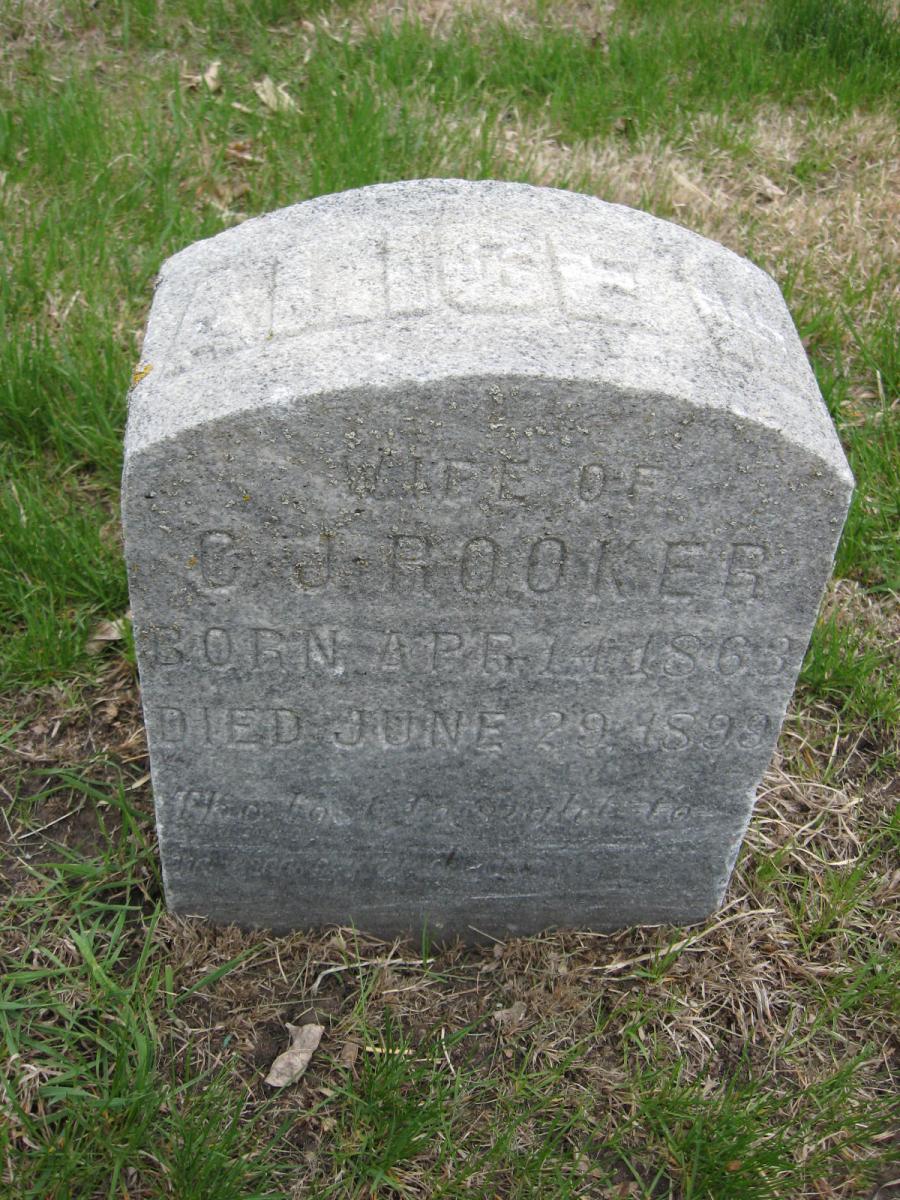REMEMBER WHEN . . . Volume 1
ARTICLES FROM DISCOVER THE TREASURES
- HILLSIDE TRIANGLE
- THE OPERA HOUSE
- ROSE BUILDINGS
- WILMOT AVENUE
- THE FIRST -- AND ONLY -- AIR MAIL FLIGHT FROM BURLINGTON
- BARBER SHOPS
- FIRE AFTERMATHS
- CIRCUS PARADE THROUGH DOWNTOWN BURLINGTON IN 1908
- KORTH BUILDING
- THREE BANKS
- WISCONSIN CONDENSED MILK CO. - 1903
- SOME "ORPHAN TRAIN" TRAVELERS FOUND HOMES HERE
HILLSIDE TRIANGLE February 2015
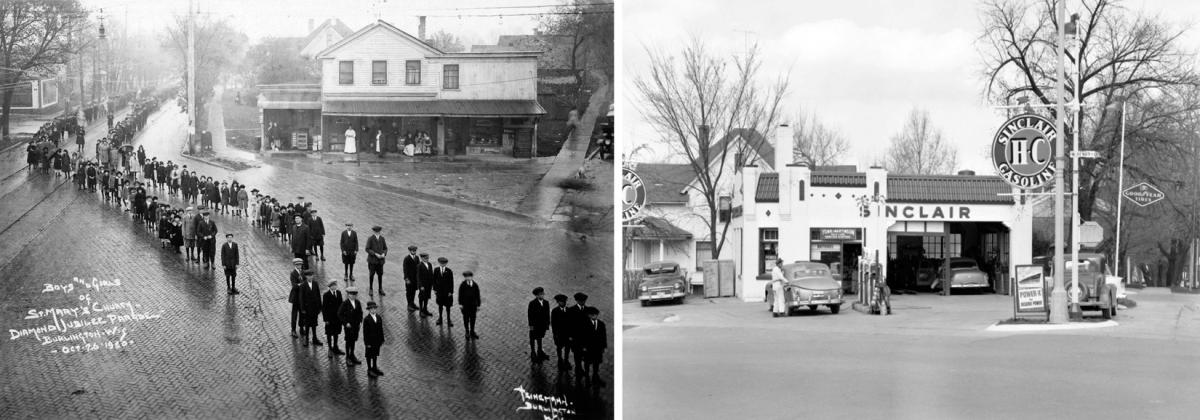
The boys and girls of St. Mary’s parish pause at the intersection of Geneva (now Milwaukee Avenue), McHenry, and Jefferson streets on October 26, 1920, while participating in a parade celebrating the 75th anniversary of the parish’s founding in the mid-1840s. The parade, which passed through the principal streets of Burlington on the way to St. Mary’s Church, was headed by the Burlington Harmony Band and followed by city officials, old settlers, and visiting priests in autos, the Knights of Columbus drum corps, and the school children and members of the congregation and its various societies. Rev. Joseph Van Treeck, St. Mary’s pastor at that time, is seen in the center of the photo standing between the two lines of marchers. Note also the brick streets and the Interurban electric train tracks on Geneva Street.
The photograph was taken by Otto Heinemann, who had a photography studio in downtown Burlington from 1915 through 1920. The photo, one of a series that Heinemann took of St. Mary’s Diamond Jubilee parade, was donated to the Burlington Historical Society by Gary Weis.
At the time of the parade, the building shown in the triangle housed Schemmer and Rossmiller’s Hillside Grocery store. Frank Schemmer had purchased the property from Henry Cook in 1875 as a site for a cobbling shop and his family’s living quarters. In the early 1880s, Schemmer built an addition and started a general store, selling groceries and dry goods. In 1894 Frank took his son, Charles, into the grocery and dry goods business, with Charles buying the business from his father in 1908. Following Charles Schemmer’s death in December 1913, his wife, Mary, sold an interest in the store to her brother, George Rossmiller.
In 1921 Harry A. Terry, a World War I veteran who had been a city mail carrier (and would eventually return to that occupation), bought the Hillside Grocery business from Schemmer and Rossmiller. Terry also moved his family into the living rooms in the back of the store. In 1925 Terry bought the property from the Frank Schemmer estate.
In 1927 Terry leased part of the property to the Deep Rock Oil Co., which built a gasoline filling station on the premises. Terry also razed part of the store building. The Deep Rock station opened in 1928 with Christ R. Johnson as manager. Later in 1928 Terry leased his Hillside Grocery store to George Schumann and Leo Schenk for a 5-year term. Schumann and Schenk dissolved their partnership in Hillside Grocery in July 1933, with Schumann continuing the business under the name Schumann's I.G.A. Store. Later in 1933, when the 5-year lease with Terry expired, Schumann moved his grocery business across the street to the Yanny building at the corner of Jefferson and McHenry streets.
In 1934 Mr. and Mrs. Francis J. Schiller rented the store portion of the Terry building and opened a recreation center offering billiards and other games and a soda fountain. The Schillers’ Dine-a-Mite Club lasted only a few months. In 1935 Henry C. Lang and Marvin Whitton opened a heating, plumbing, and refrigeration business in the store area. Joseph F. Voelkering also moved his sewing machine, vacuum cleaner, and washing machine exchange into the building. Whitton moved his appliance business to a shop on Chestnut Street in 1937 and Lang moved his plumbing business to his Chestnut Street home in 1938.
Terry then had the frame store and residence building torn down and a brick filling station erected, with the Terry family moving to a house on Schemmer Street. The station was leased to the Sinclair Oil Co., which opened the filling station in December 1938 with Bernard Kempken in charge. Irvin Anderson succeeded Kempken in 1942 and operated the Sinclair station and service garage until 1946 when he sold the business to Albert Horter and Ernest Polze.
In 1954 Francis Menheer, who had bought the business from Albert Horter, sold it to Walter Yonk, Jr., and Robert Martinson. The second photo, taken by Emmett Raettig, shows the station in 1956. Yonk and Martinson ran the business until 1961 when they sold it to Fred Beck, who ran the business until 1972.
Since that time, businesses in the building have included AWD Tire Sales, AWD Auto Center, Bob Koehn’s Hillside Auto Center, and Wilson Classic Car center owned by Errol Wilson and Lance Poltrock. The building is currently occupied by State Auto Sales.
THE OPERA HOUSE January 2015
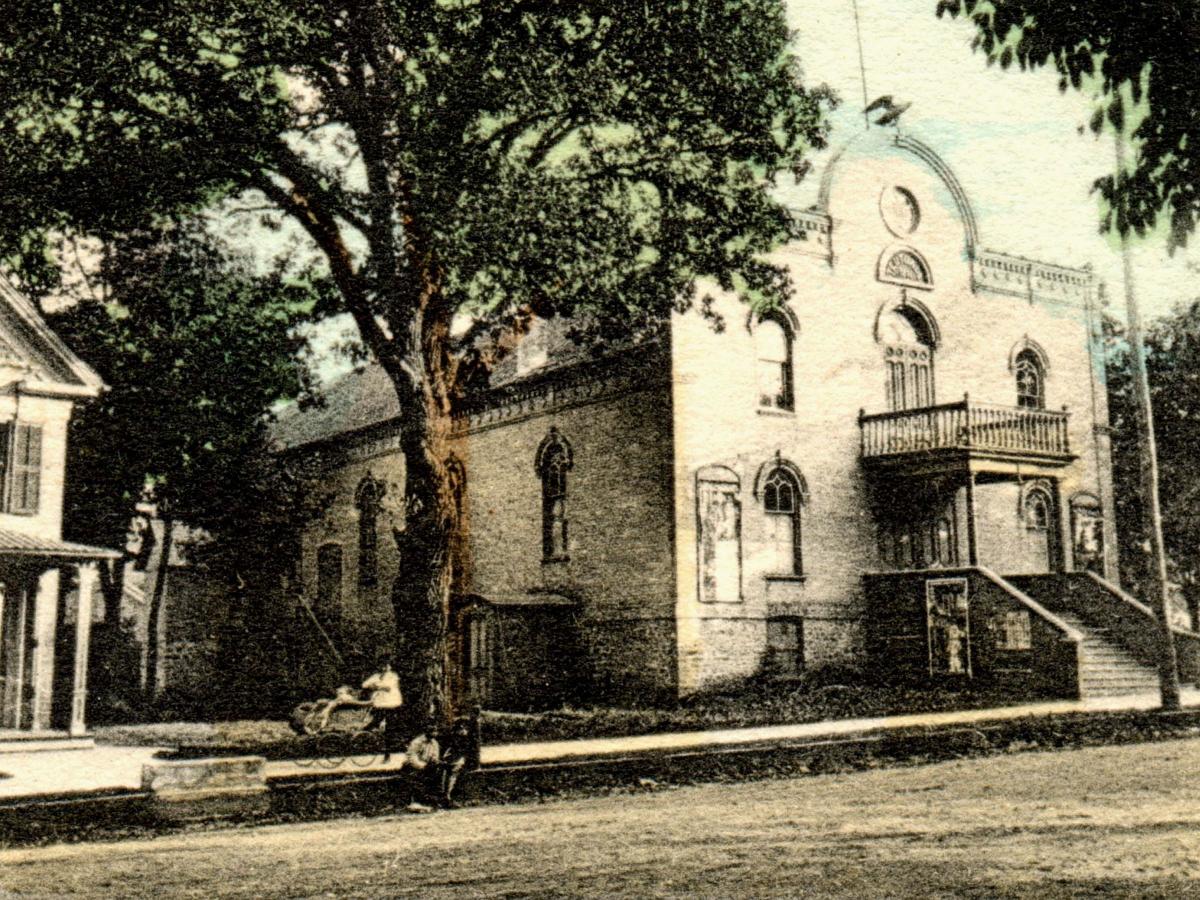
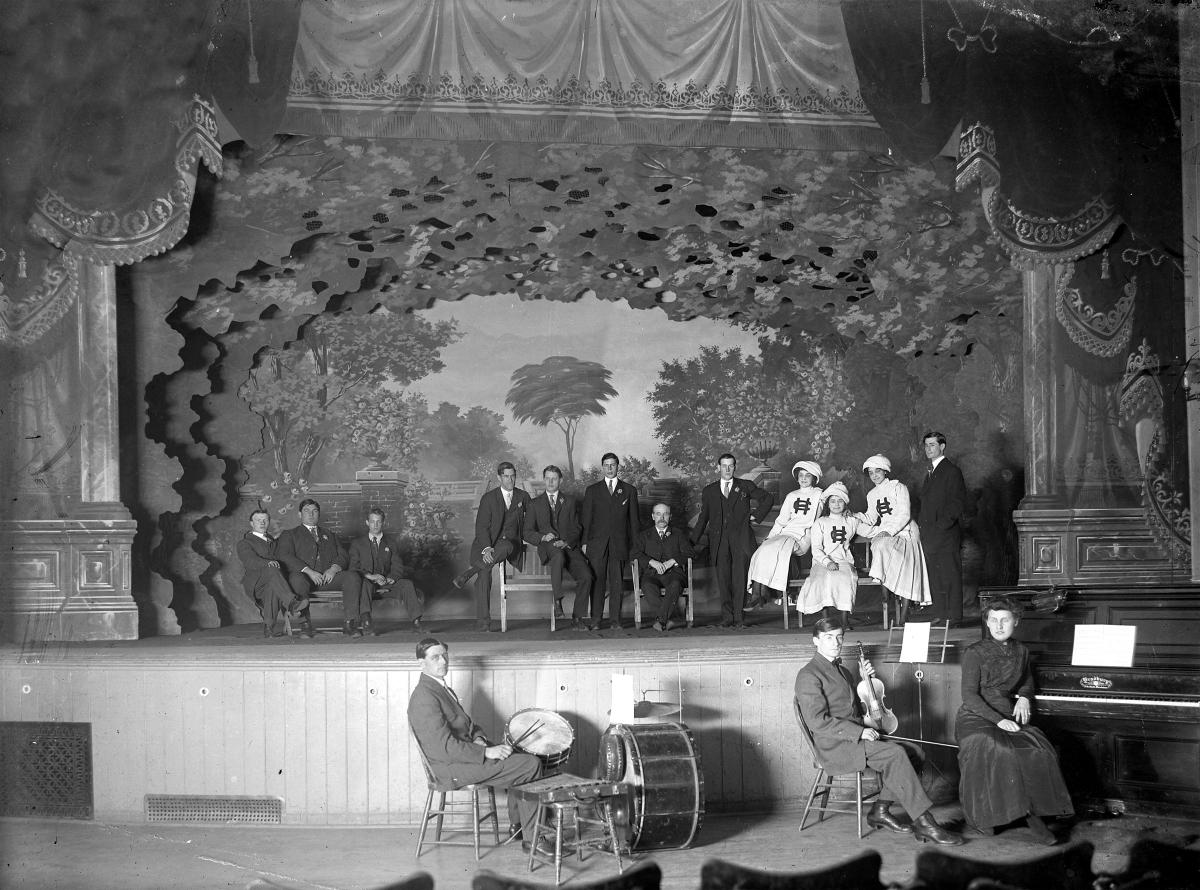
Burlington was once able to boast of an Opera House having the second largest stage in Wisconsin. That building, which stood on the corner of what is now N. Kane Street and Milwaukee Avenue, and its stage are shown in the accompanying photos from the collection of the Burlington Historical Society. The photo of the building is from a postcard published about 1903 by S. M. Reinardy. The photo of the stage was taken by Howard A. Wood in 1911. Sitting on the stage are members of a traveling vaudeville company. Standing at right is Burlington’s Howard Colburn, who was managing the building at that time. The three-piece orchestra in front of the stage called themselves LeGrande Trio. The members were Burlington musicians Fred Boulden on drums, Theodore Korn on violin, and pianist Laura Prasch.
The Teutonia Singing Club had been organized in May 1853 with its purpose being “the elevation and refinement of the popular song and the recreation of social life.” The charter members included Joseph Bock, William Riel, Henry Martensen, Francis Reuschlein, Jacob Muth, Julius Lueck, Dr. Frederick Kords, Joseph Wackerman, Sr., John Riess, Richard Weygand, Conrad Bosshard, William Funk, Charles Wagner, Frederick Keuper, Mathias Bachmeier, Henry Burhans, Casper Scheidt, and William Rein. A few evenings later, Jacob Wambold, Martin Schafer, Ciriak Prailes, Frederick Willhoft, and Jacob Oelten joined the ranks.
Until 1870 the Singing Club experienced financial difficulties. To rent a meeting room, buy a stove and wood, and get other necessities were matters of great concern at the beginning. It was even difficult to obtain candles to light up the meeting room. However, after a few public concerts and a grand ball swelled the treasury, the club was able to buy a club banner and a piano. By the late 1850s, the club had assumed the leading place in the social life of Burlington. In every celebration, or festival, or other public gathering in the village, the club took a prominent part. Heading every procession, floating from every platform was the club’s banner.
After the German Dramatic and Turner societies joined the Teutonia Singing Club in what they called the Teutonia Society, the members – as one club – bought the property and erected the building that was first known as “Teutonia Halle” and later as the Opera House and then the Orpheum Theatre. The dedication banquet was scheduled for October 8, 1871, but hearing of the Great Chicago Fire that night, Society members packed the big roasts and everything that went with them and sent them by railroad to the sufferers.
With the hall finished, theatricals, music, and athletic sports flourished in the village. There was now a place where concerts could be given, plays produced, and men could exercise on the turning poles and bars. The hall, which had a seating capacity of 600, was also used over the years for dances, masquerade balls, banquets, school commencements, political meetings, fund-raising benefits, vaudeville shows, and other community activities. It was even set up at times as a roller skating rink. After moving pictures became popular around 1910, the building was also used as a movie theatre.
In May 1877 the Society also started a park project. The members purchased 10 acres out on West Chestnut Street overlooking the White River. There they established Teutonia Park, which hosted community picnics and other outdoor activities until 1887, when the land was sold. Today the park is remembered in the name of Teutonia Drive.
Electricity was first installed in the Opera House in 1888, with 55 lights illuminating the main hall. In 1908 a modern stage (shown in the 1911 photo) replaced the original stage, which had been 30 feet deep and 46 feet wide. The new stage was 32 feet deep, 55 feet wide with an opening of 32 feet, and 60 feet high at the highest point. The auditorium was also enlarged by 30 feet. In 1916 the basement was remodeled to furnish additional dining room, and in 1924 the building received a new and modern front. Later, the building was leased to a theatre firm and remodeled into the Orpheum Theatre. The old level floor was replaced by a sloping floor and theater seats were installed.
In 1928 Teutonia Society members voted to disband, the Society’s back having been broken by Prohibition. A private company, the Teutonia Corporation, was formed and incorporated to engage in the purchase and improvement of real estate and to operate and manage theatres and public halls. It took over the building, continuing the lease to the theatre firm.
Early in the morning of January 23, 1930, with the temperature around 12 degrees below zero, a fire of undetermined origin was discovered in the building. The fire trucks and members of the department were on the job promptly, but before they arrived the interior was a mass of flames. Then came explosions that caused large portions of the brick walls to be thrown great distances and sections of the roof to be hurled clear of the building. The explosions also sent sparks and flying embers spreading flames throughout the building. The firemen were able to save the surrounding buildings, but the community’s social and cultural center, which through three generations had fostered the love of music and drama, encouraged individual expression of the finer arts, and promoted social fellowship, was destroyed.
ROSE BUILDINGS December 2014
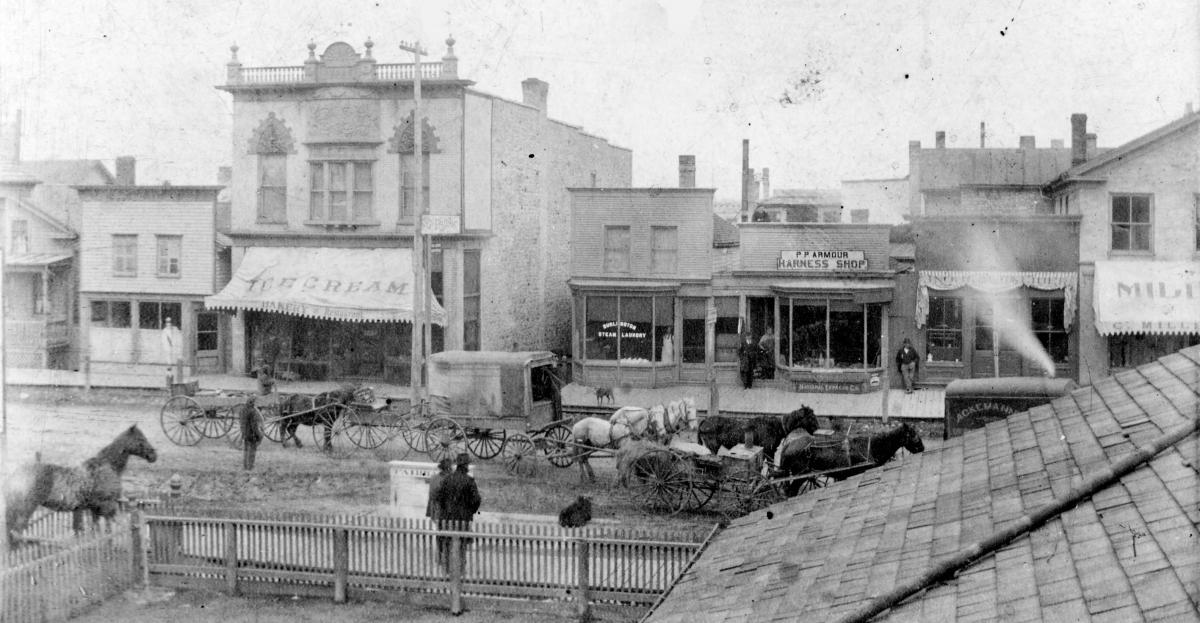
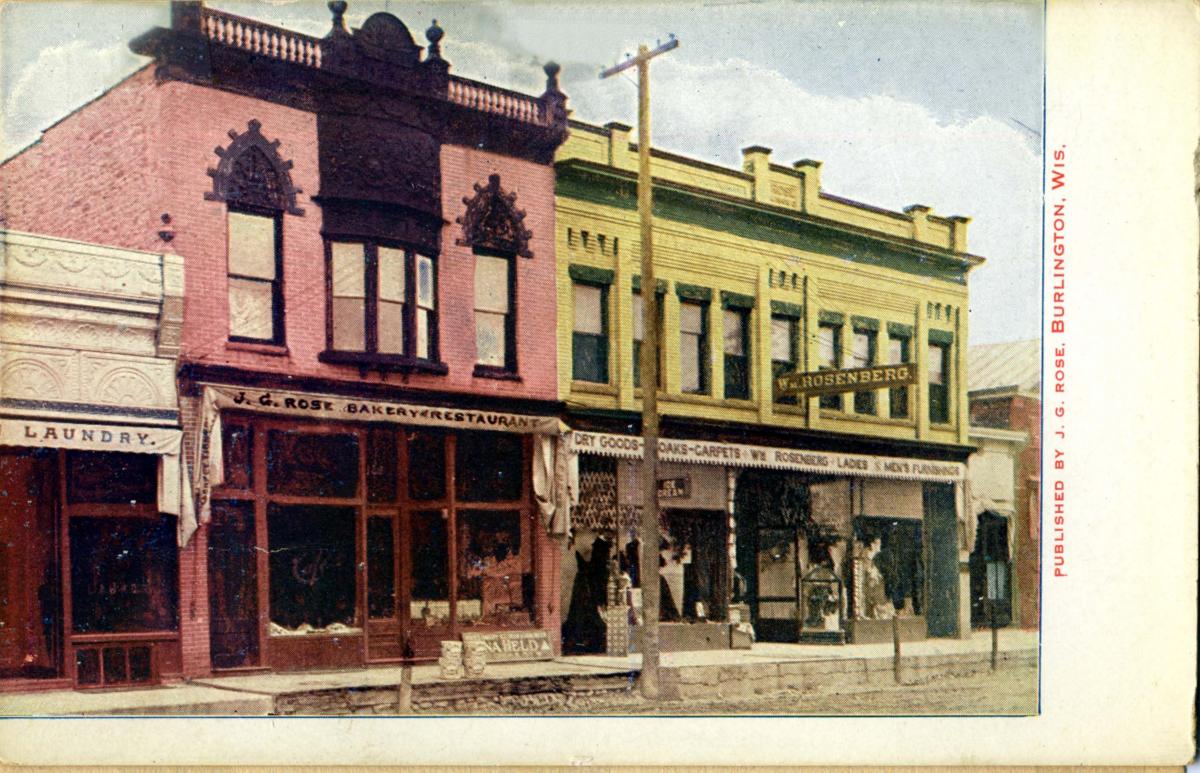
The Rose buildings on the north side of Chestnut Street west of Milwaukee Avenue are shown in the circa 1908 photo (right) published as a colored post card by John G. Rose, who owned the two buildings. The post card was found in a scrapbook kept by Mark Hannas, a lifetime Burlington resident. The scrapbook, along with other Hannas memorabilia, was donated to the Burlington Historical Society after his death in 1991.
The rose-colored building with the “medallions” over the upper windows was built by Rose in 1895 to house his bakery and restaurant business. It remained as “Rose’s Bakery” for nearly 80 years as John’s son, William, and grandson, Alex, and their families continued the business until 1973. Occupants of the building after Rose’s Bakery closed have included the Realty Shoppe, Dr. Arnold Grossman’s optometry office, and Neighborhood Optometry LLC.
The large yellow brick building to the right of the bakery was also built by Rose. It replaced two smaller store buildings (shown in photo at left) which Rose had purchased in 1894 from the Wendelin Miller estate. Those buildings were moved off the property in 1906 to clear the site for the large Rose building. Rose leased the first floor of the new building to William Rosenberg for his dry goods and clothing store. An apartment and offices occupied the second floor.
Rosenberg had started his business, which he then called “Boston Store,” in 1899 in the building on Pine Street where Beaches Tanning Salon is now located. Rosenberg moved in 1902 to the building on Chestnut Street that later housed the Garvey and Henney drug stores and is now occupied by Oldenburg Insurance. Rosenberg remained there until 1906 when he moved to the newly built Rose building.
The Rosenberg store occupied the Rose building until 1915, when William moved his store to the Keuper building on Pine Street, which was most recently occupied by the Schuette-Daniels Furniture Store. The Rosenberg store remained at that location until 1939, when it went out of business and was replaced by a Montgomery Ward store.
After Rosenberg’s moved out of the Rose Building in 1915, John Rose leased part of the first floor to a tailor and opened a five and ten cents variety store in the remainder. After the tailor shop closed in 1916, Rose used the entire first floor for his variety store.
In 1920 Rose sold the bakery business to his son, William, and turned to helping his daughter, Cecilia “Cele” Rose, in the variety store. In 1939 Cele bought the Rose building from her parents’ estate and joined Butler Brothers’ Ben Franklin chain of variety stores as a franchiser. At that time, she was the only woman among that chain’s 400 franchisers.
Cele continued her variety store until 1943, when she leased the Rose building to the Kroger grocery store chain. The Kroger store remained in the Rose building until 1949, when it moved to a new store building next to the Plaza Theatre. Following a short-term occupancy of the Rose building by a women’s clothing shop, the Atlantic & Pacific Tea Co. leased the building in 1952 and operated an A&P grocery store there until 1966. Since then, the building’s occupants have included a Western Auto store, a Goodwill budget store, the Bridal Suite shop and A Cut Above Hair Salon, Art Etc., El Chava Super Market, and the current Los Corrales Super Market.
The shorter building partially shown to the left of the bakery building housed Frank Zwiebel’s Burlington Steam Laundry. Zwiebel had purchased the lot from John Rose in 1906 and put up the building for his laundry business. In 1931 Frank’s nephews, Raymond and Louis Zwiebel, bought the business from Frank. The Zwiebels closed the laundry in 1943 when, because of a wartime wage and price freeze, they could not obtain employees. The laundry was reopened by Robert Zwiebel early in 1945 under the name Snowhite Laundry.
Later in 1945, George Rider, who owned Academy Cleaners, bought the laundry building from Raymond and Louis Zwiebel, and Rider and Martin Schroeder, who formed a partnership, bought the laundry business and equipment from Robert Zwiebel. Renamed Sno-White Laundry, the business remained in the building until 1969. Subsequent occupants of the building have included Casuals Unlimited, Karow’s II Kitchen and Bath Shop, Country Home Center, Custom Floor & Wall Co., Edward D. Jones & Co., H & R Block, and the current Racine County Opportunity Center.
WILMOT AVENUE October 2014
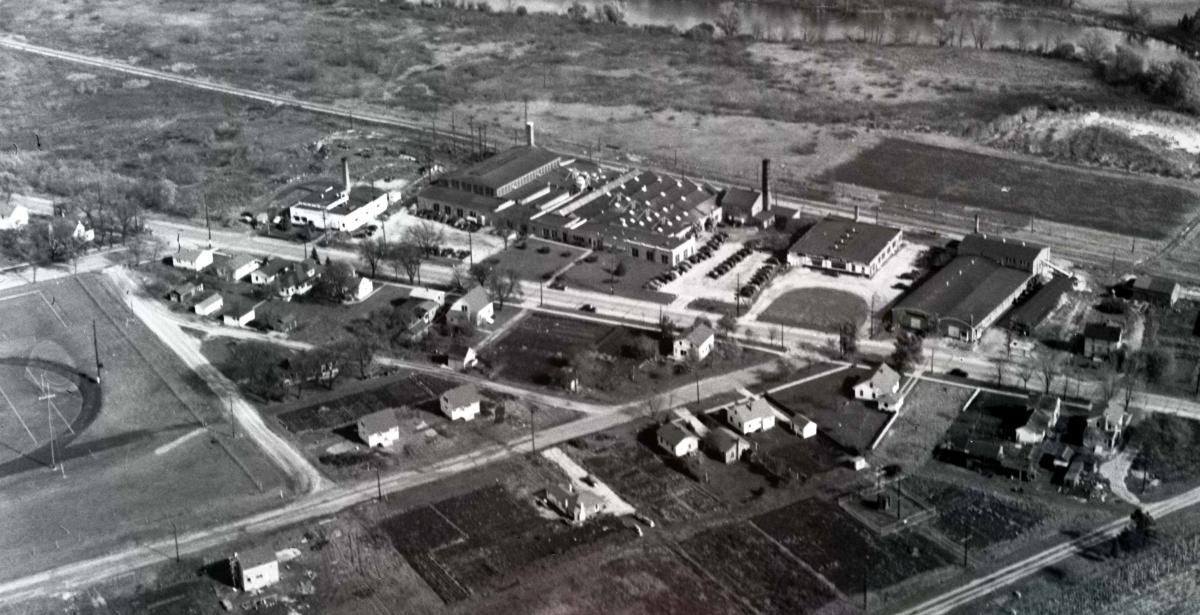
Several industrial buildings, including the large Brass Works complex, lined the east side of Wilmot Avenue (now S. Pine Street) between Robert Street and Wainwright Avenue when this aerial photo was taken in the spring of 1949. The photo appeared in the April 12, 1949, Free Press published by Elmer Ebert. The Mary Street end of the Burlington High School (now Karcher Middle School) football field is seen at the lower left.
The square, white-walled building at the left near the Robert Street intersection housed the Burlington Sanitary Milk Company. The building was erected in 1935 by Andrew Adam, who moved the company from its former building on E. Water Street (near the Malt House). The company, which shipped milk to the Chicago area, also bottled milk for over-the-counter and local store sales until 1955. The company went out of business in 1968. The building’s current occupant is Jim’s Auto Body, which was moved to the building in 1986 by owner Jim Ratchek.
The Burlington Brass Works complex is set back from the road and extends along the railroad tracks from the large foundry building with the glass-windowed upper level to the small building with the tall smokestack in back of a parking lot. The company started in 1902 when inventor Ole O. Storle developed an industrial steam valve and, with Gustave C. Rasch and John Gill, built a small factory on the 5 acre tract. In 1905 an engine room and a moulding room were added. Charles B. and C. Roy McCanna bought the business in 1906, added products such as the “Kant-Leak” valve for sink faucets, and started plating and polishing departments. The large foundry building was put up in 1920, a one-story office building in 1931, and an addition for the assembly and shipping departments and for storage and loading in 1936. Besides plumbing supplies, the company also made bearings, hub caps, and other automobile parts. During World War II and the Korean War, it made shell casings, detonator parts, and engine bushings. The company was sold to a Connecticut firm in 1975, and the plant was closed in phases in 1979. Today, various businesses and portions of Love, Inc., occupy the former Brass Works buildings.
The square, white-sided, one-story building with the semi-circular driveway was built in 1923 by the Burlington Factory Advancement Co. to house a dish washing machine factory. When that proposition fell through, P. Clifton Holmquist bought the building and started a household woodenwares factory. He began manufacturing curtain stretchers in 1924 but, after his unexpected death in 1925, his widow sold the business to a Chicago firm. She retained ownership of the building and leased it to the Cunningham Buick Co. for automobile storage for a few years. In 1929 Gustave Rasch, James Malcolm, and George Weiler incorporated a company called the W. W. Sterling Co. to buy the waste of woolen and cotton mills, reprocess it, and sell it for manufacturing purposes. The company was not successful, and it went out of business in 1934.
In 1938 E. L. Rinehart bought the building and, with Walter and Richard Huening, started Standard Foods, Inc., a fast-freeze locker plant to handle home-killed and packer-killed meats and other products. Richard Huening leased the plant from Rinehart until 1940, when William Kares became manager. The business, licensed as a slaughter house and meat packer, was bought by Arthur and Blanche Lederer in 1945, and the name was changed to Burlington Foods, Inc. In 1964 the Lederers sold the business to Jack Donalds, who operated it as Donalds’ Foods for 2 years. Merkt’s Cheese leased the building in 1966 and James King and Robert and Norbert Merkt opened a sausage manufacturing plant, which closed in September 1967. Subsequent businesses in the building included Troy Plastics, ECM Motors, Burlington Photography Unlimited, Southern Lakes Photo Finishing, Amer-Econ Furniture Refinishers, Discount Flooring, Stan’s Glass, and Bob’s Pedal Pusher. Love, Inc., expanded into the building in 2012.
The twin rounded-roof buildings at the right, backed by the two-story building near the railroad tracks, housed the John J. Wolf sauerkraut and pickle factory from 1919 until 1949. Wolf bought the site of a former malting house that had burned in 1902, and put up one of the rounded-roof buildings for tank and storage purposes and the two-story building for a work room in 1919. He added the second rounded-roof building in 1923 and, in 1929, built a four-pump gasoline filling station in front of the factory. Wolf added a sorting shed in 1934. Sauerkraut production, which totaled about 725 tons in 1920, grew to about 2,000 tons a year (except for drought years) in the 1930s and 1940s. The kraut was shipped to canners around the country, with some sold under the “Burlington” label. After the sauerkraut plant closed in 1949, Lee Koch bought the property and moved his farm implement business there. A McCormick farm equipment store followed Koch in 1956. Today, segments of Love, Inc., occupy the buildings.
THE FIRST -- AND ONLY -- AIR MAIL FLIGHT FROM BURLINGTON
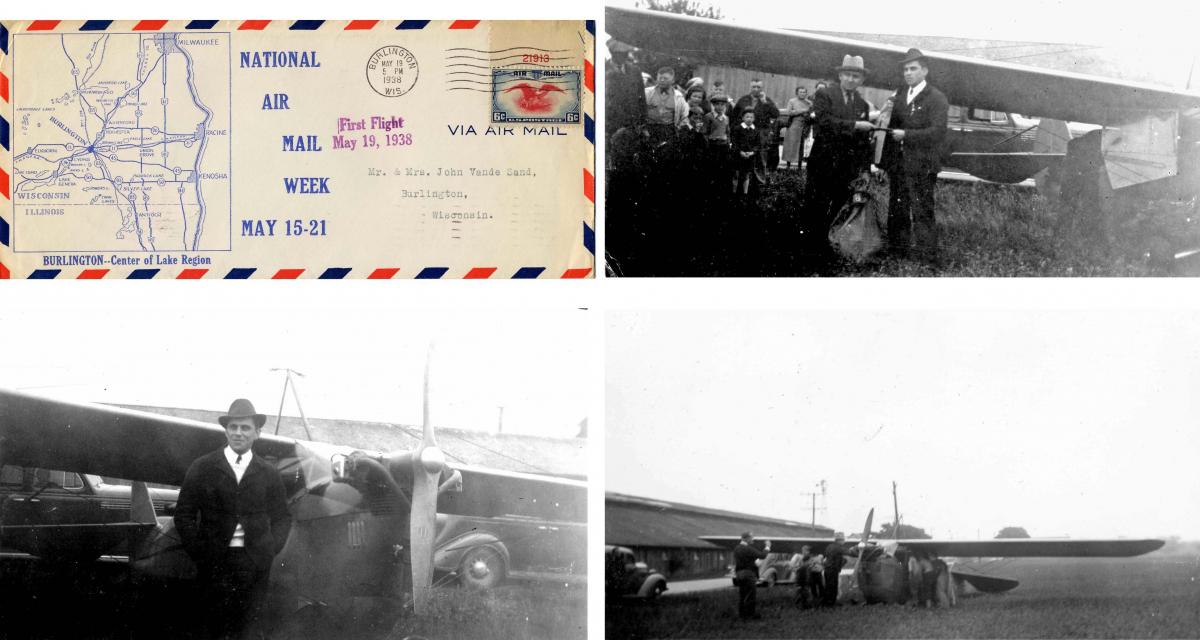
Photos: Top left - Envelop mailed as souvenir of the flight; top right - Postmaster Louis Reuschlein hands mail sack to pilot Roman Eckert; bottom left - pilot Roman Eckert; bottom right - Eckert's Aeronca plane on the John Eckert farm before takeoff.
A crowd of nearly 200 interested people assembled at the John Eckert farm, 2 miles east of Burlington on what is now Highway 142, on Friday, May 20, 1938, to witness the first air mail flight from Burlington. Among the crowd were several Burlington post office employees, including Aloysius “Al” Vande Sand, whose black and white photos accompany this article.
The government had designated the week of May 15-21, 1938, as National Air Mail Week, celebrating the 20th anniversary of air mail service in the United States. The original 218-mile route twenty years before, which went from New York to Washington, D.C., had expanded to about 32,400 miles in the domestic system and 30,450 miles in the foreign system. From 1918 to 1937 the annual number of air mail pieces grew from 713,000 to almost 200 million. For 6 cents in 1938, a letter could be sent across the continent in a few hours.
Burlington joined many other Wisconsin cities in the celebration, sending 992 air mail letters during that week through the local post office. A thousand special Burlington air mail envelopes, such as the one shown at the upper left, and several thousand special air mail stamps were sold at the post office during the week.
The Aeronca two-place plane that flew the first air mail from Burlington to Milwaukee carried 789 letters in a sack strapped to the passenger seat. The plane was owned and piloted by Burlington’s Roman Eckert (lower left), who took off from a hayfield on his father’s farm. Most of the letters were in the Burlington souvenir air mail envelopes that the local post office had printed for the occasion.
Burlington postmaster Louis F. Reuschlein and postal clerk Emmett Raettig, escorted by a Racine county sheriff’s deputy, took the mail from the post office to the Eckert farm. Postmaster Reuschlein and pilot Eckert posed near the plane for the cameras (upper right) and then Eckert boarded the plane. At 4:58 his all-yellow, wooden-propellered, 36 horsepower Aeronca lifted from the ground. He touched ground again at 5:18 on a gravel runway at the Milwaukee county airport (now called Mitchell Field) where a temporary post office had been set up to handle mail coming in from points all over the state.
Eckert’s flight time of 20 minutes was the time specified in the terms of his commission to fly the mail from Burlington to Milwaukee on the day specified for National Air Mail Week.
Burlington’s assistant postmaster Henry Weygand had gone to Milwaukee and was at the airport there to welcome pilot Eckert upon landing. With him were Mrs. Weygand and their three children, and they all enjoyed the experience of watching the planes come in from all over Wisconsin.
The Milwaukee postmaster, together with a staff of thirty clerks, was in charge of the work at the airport.
The Burlington plane landed just after the arrival of a huge streamlined mail liner from Minneapolis that was to help in carrying the mail on to distant points. According to Mr. Weygand, the amusing contrast when Eckert taxied up alongside the big plane brought a laugh from the crowd assembled to watch the planes come in.
Grouped about the hangar were gatherings of people whose interest centered on the arrival of certain planes, Mr. Weygand noticed. As loudspeakers announced arrivals of mail planes, the interested group surged forward, watched the mail unloaded, and then departed.
The arrival of a woman pilot caused considerable excitement. Newspaper and amateur photographers crowded around her for pictures. People in the crowd tried continually to get the autographs of pilots as they came in. Mr. Eckert obligingly gave his signature to several souvenir hunters.
A tremendous amount of work was entailed at the airport in getting the air mail off, according to Mr. Weygand, and it kept the big force busy until late in the evening. The post office department had issued orders that every letter had to be back-stamped at the airport because storms and bad weather generally throughout the state had caused postponement of local air mail day from Thursday, the 19th, to Friday, the 20th.
As fast as the mail could be stamped and sorted, it was loaded onto two large air liners, the regular Milwaukee mail plane and the special streamlined mail plane from Minneapolis, one of the newest and finest in government service.
East bound mail was loaded on the plane that would fly directly across Lake Michigan to Detroit, and from there be dispatched to points east. West and south bound mail was flown to Chicago and dispatched through the regular air mail routes.
After sending the mail off safely at the Eckert farm, postmaster Reuschlein drove to the Milwaukee airport and spent the remainder of his day at the office on the field.
BARBER SHOPS November 2012
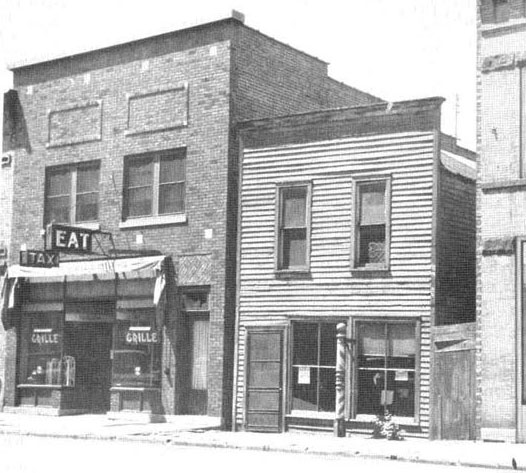 Charles Mole’s barber shop – one of the last wooden building in Burlington’s downtown area – is shown about 1948 on North Pine Street next to the V-Grille, where Harold and Alice Boulden also had a taxi stand. Mole, who bought the barber business from Frank Stang in 1893, also bought the property in 1895. He operated his shop until 1949, when he retired. Mole’s building also had the last wooden sidewalk in Burlington, which was replaced with paving bricks, rather than concrete, in 1928 to protect an ivy vine which had covered the front of the wooden building. The wooden building was razed in 1949. In 1953 Edwin Boyle built a brick office building, which was used by three generations of Boyle family lawyers. The building has been occupied by Keefe Real Estate, Inc., since the spring of 2011.
Charles Mole’s barber shop – one of the last wooden building in Burlington’s downtown area – is shown about 1948 on North Pine Street next to the V-Grille, where Harold and Alice Boulden also had a taxi stand. Mole, who bought the barber business from Frank Stang in 1893, also bought the property in 1895. He operated his shop until 1949, when he retired. Mole’s building also had the last wooden sidewalk in Burlington, which was replaced with paving bricks, rather than concrete, in 1928 to protect an ivy vine which had covered the front of the wooden building. The wooden building was razed in 1949. In 1953 Edwin Boyle built a brick office building, which was used by three generations of Boyle family lawyers. The building has been occupied by Keefe Real Estate, Inc., since the spring of 2011.
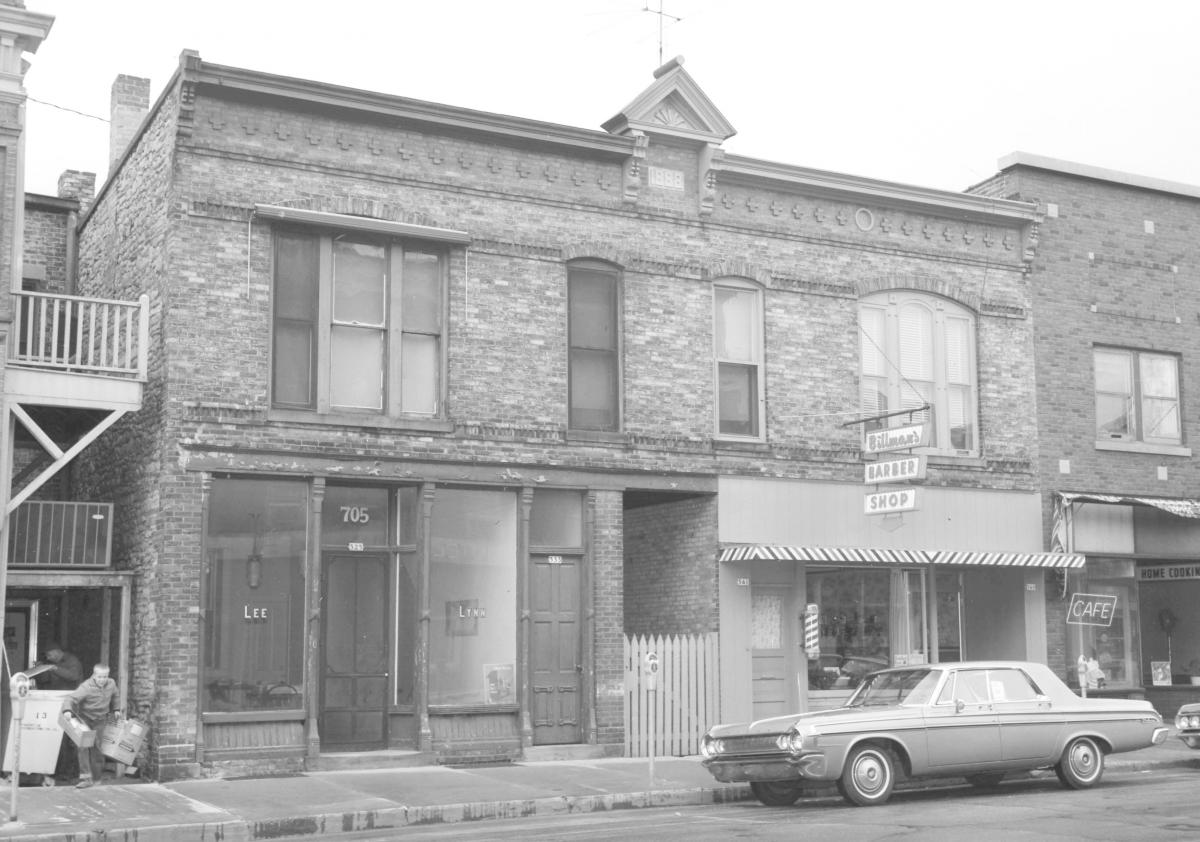 Wilbur Billman opened his barber shop in the Verhalen building at the right on North Pine Street in 1957 after moving from the basement of the Finke building on the corner of Chestnut and Pine Streets. Former barber Lee Lynn’s name is still on the window of the adjacent Wehmhoff building at the left in the photo taken in 1964 by Burlington photographer Emmett Raettig. Lemilo “Lee” Lynn, who retired in 1961, had opened his barber shop in 1923 after working for other Burlington barbers since 1913. The Wehmhoff and Verhalen buildings were built together in 1888 with an opening separating them on the ground floor, but with the second floor extending across both buildings. The Lynn barber shop site is occupied today by The Whisker Works pet grooming business. The Billman site is occupied by Rocking Fun Music.
Wilbur Billman opened his barber shop in the Verhalen building at the right on North Pine Street in 1957 after moving from the basement of the Finke building on the corner of Chestnut and Pine Streets. Former barber Lee Lynn’s name is still on the window of the adjacent Wehmhoff building at the left in the photo taken in 1964 by Burlington photographer Emmett Raettig. Lemilo “Lee” Lynn, who retired in 1961, had opened his barber shop in 1923 after working for other Burlington barbers since 1913. The Wehmhoff and Verhalen buildings were built together in 1888 with an opening separating them on the ground floor, but with the second floor extending across both buildings. The Lynn barber shop site is occupied today by The Whisker Works pet grooming business. The Billman site is occupied by Rocking Fun Music.
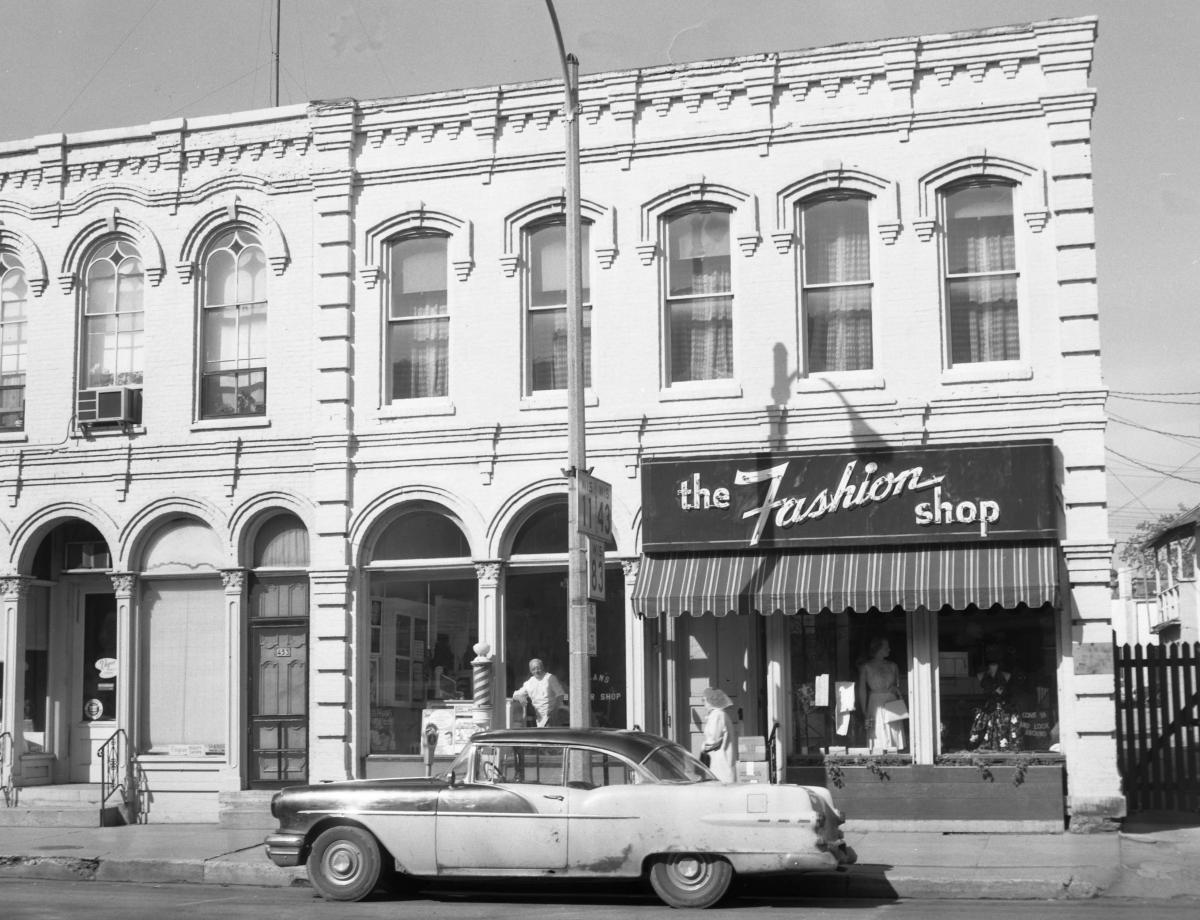 A barber looks out the window of Allan’s Barber Shop in the former Miller Building on North Pine Street in a photo taken by Emmett Raettig in 1962. Allan Vogt was the last of several barbers, including William Hannemann and Andrew Jacobs, who had barber shops in the south store of the two-store Miller Building from the early 1900s until 1965. After Vogt closed his shop in 1965, the adjacent Fashion Shop, a women’s clothing store which had been in the north store since 1940, expanded into the former barber shop space. The Miller Building was purchased by the Meinhardt Bank in 1957 and, after the Fashion Shop closed in 1970, the building was demolished, along with two adjoining buildings, to make way for a bank drive-in.
A barber looks out the window of Allan’s Barber Shop in the former Miller Building on North Pine Street in a photo taken by Emmett Raettig in 1962. Allan Vogt was the last of several barbers, including William Hannemann and Andrew Jacobs, who had barber shops in the south store of the two-store Miller Building from the early 1900s until 1965. After Vogt closed his shop in 1965, the adjacent Fashion Shop, a women’s clothing store which had been in the north store since 1940, expanded into the former barber shop space. The Miller Building was purchased by the Meinhardt Bank in 1957 and, after the Fashion Shop closed in 1970, the building was demolished, along with two adjoining buildings, to make way for a bank drive-in.
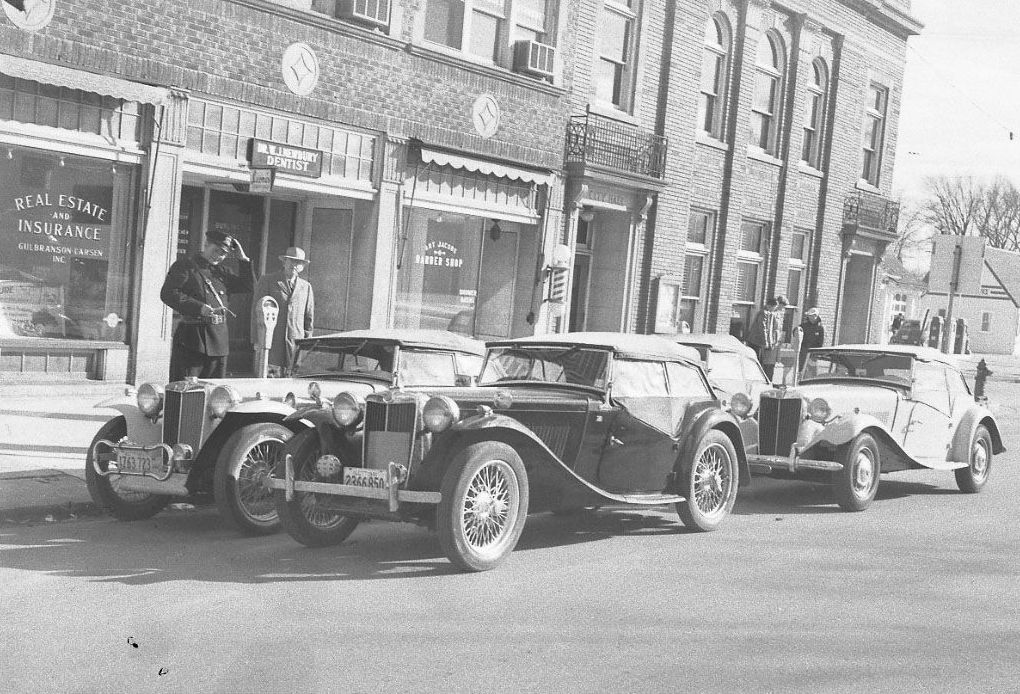 Police officer Edward Wisnefsky, shown with Chief Roy McCourt, looks at four MGs parked in front of Art Jacobs’ barber shop and the adjoining businesses on North Pine Street in a Free Press photo taken in November 1951. The automobiles belonged to members of the Midwest Sport Car Club of Chicago who had made a reliability run from Chicago to Burlington. Jacobs, who had once “held down a chair” in Charles Mole’s barber shop, opened his shop next to the City Hall and public library building in 1927. When Jacobs retired in 1959, his son Vern bought the business and operated it until selling the business to Gaylord Johnson, who had started there in 1966. Johnson closed the barber shop and retired in 2005. The building’s current occupant, Kerkman’s SplitEnds hair salon, opened in 2006.
Police officer Edward Wisnefsky, shown with Chief Roy McCourt, looks at four MGs parked in front of Art Jacobs’ barber shop and the adjoining businesses on North Pine Street in a Free Press photo taken in November 1951. The automobiles belonged to members of the Midwest Sport Car Club of Chicago who had made a reliability run from Chicago to Burlington. Jacobs, who had once “held down a chair” in Charles Mole’s barber shop, opened his shop next to the City Hall and public library building in 1927. When Jacobs retired in 1959, his son Vern bought the business and operated it until selling the business to Gaylord Johnson, who had started there in 1966. Johnson closed the barber shop and retired in 2005. The building’s current occupant, Kerkman’s SplitEnds hair salon, opened in 2006.
FIRE AFTERMATHS October 2012
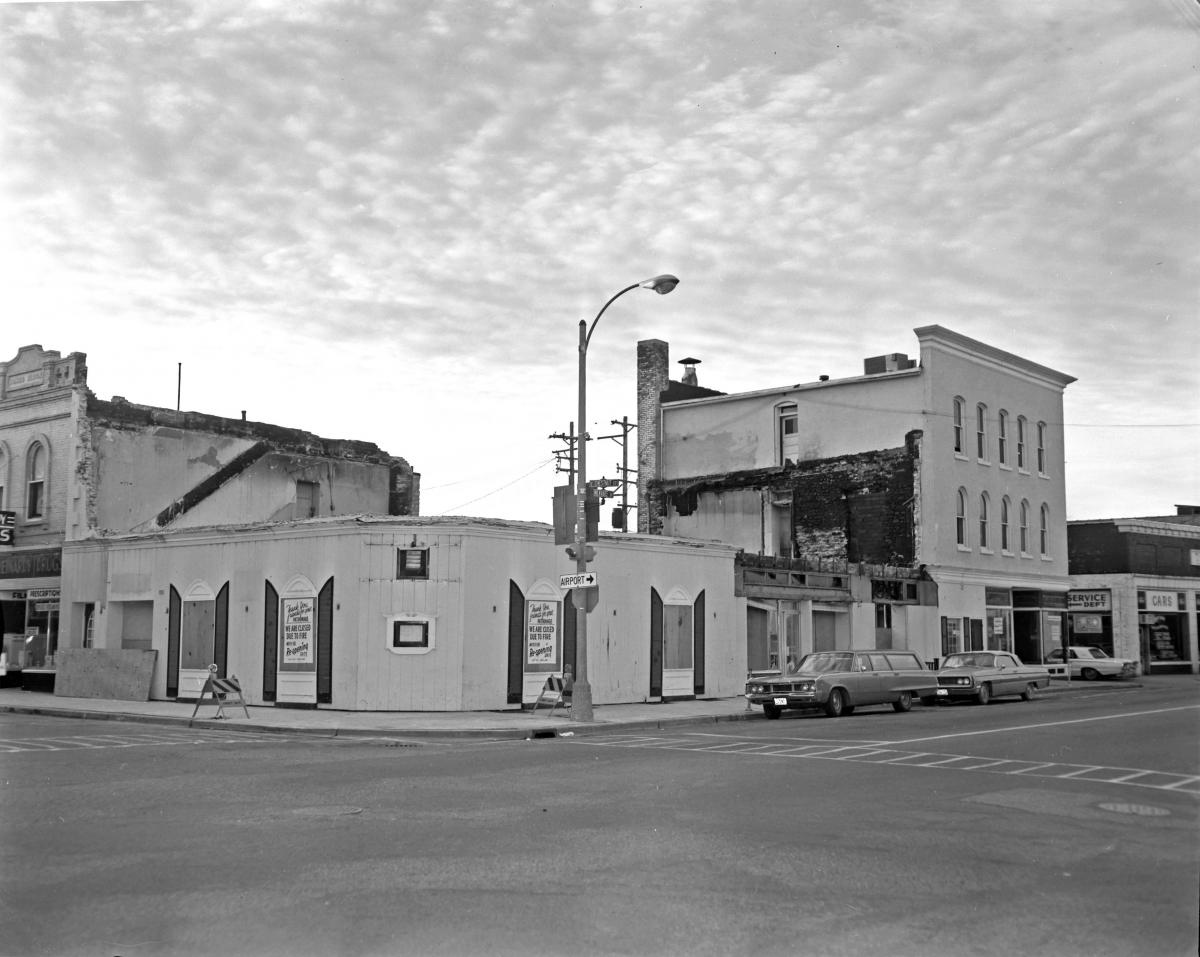 A burning piece of toast in the kitchen of the Coach Lamp Restaurant triggered a five-hour fire, which destroyed a century-old three-story hotel building on the corner of Chestnut Street and Milwaukee Avenue in October 1968. The interior of the building, originally called the Jones House and later the Fritz-Karl and then Badger Hotel, was reduced to charred ruins. Following the fire, the two top floors of the building were removed, leaving the first floor and basement (as seen in the photo taken by Burlington photographer Emmett Raettig). The building re-opened in 1969 as the Coach Lamp Restaurant. Later occupants included the Covered Wagon, the Corner House, and the Eagle’s Nest. Today, the building houses Coach’s Sports Bar and Grill, which opened there in 1992.
A burning piece of toast in the kitchen of the Coach Lamp Restaurant triggered a five-hour fire, which destroyed a century-old three-story hotel building on the corner of Chestnut Street and Milwaukee Avenue in October 1968. The interior of the building, originally called the Jones House and later the Fritz-Karl and then Badger Hotel, was reduced to charred ruins. Following the fire, the two top floors of the building were removed, leaving the first floor and basement (as seen in the photo taken by Burlington photographer Emmett Raettig). The building re-opened in 1969 as the Coach Lamp Restaurant. Later occupants included the Covered Wagon, the Corner House, and the Eagle’s Nest. Today, the building houses Coach’s Sports Bar and Grill, which opened there in 1992.
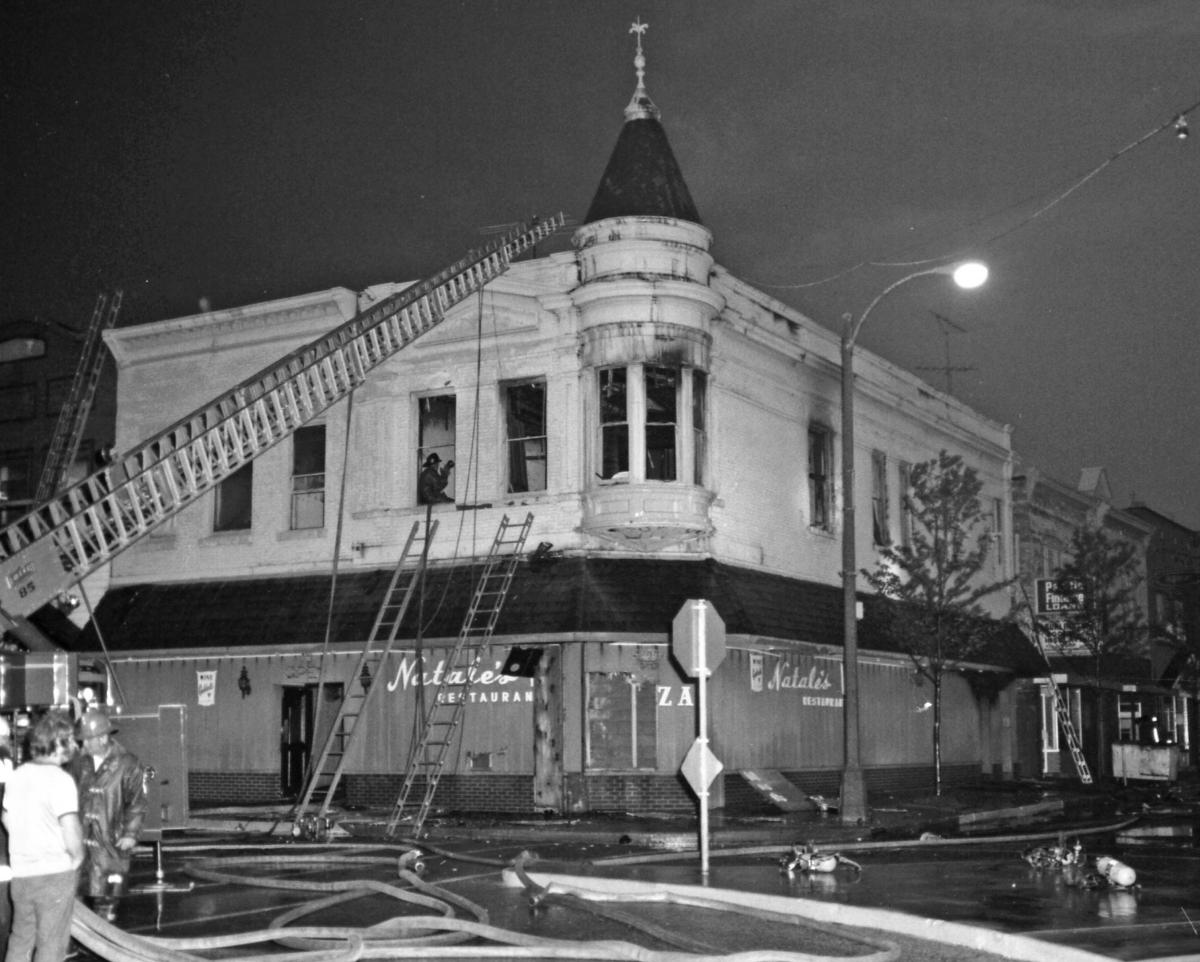
Firemen were still inside the fire-gutted Finke building on the corner of Chestnut and Pine Streets when Emmett Raettig took this photo on June 16, 1978. The fire had started in the kitchen area of Natale’s Restaurant, which occupied the ground floors of both the Finke building and the adjoining Fenn building, into which Charles and Florence Natale had expanded their restaurant in 1967. The Finke building, erected in 1902, had housed a series of taverns (and soft drink parlors during Prohibition) until 1944, when Carl Rubach opened a men’s clothing store there. The building had also housed Pieters Mens’ Wear and the Burlington Savings and Loan office prior to the Natales opening their restaurant in 1963. The upper stories of the two buildings were removed following the fire, and the Natales re-opened the restaurant in the single-story building, operating it until 1987. The building has since housed other restaurants, including the current Zumpano’s.
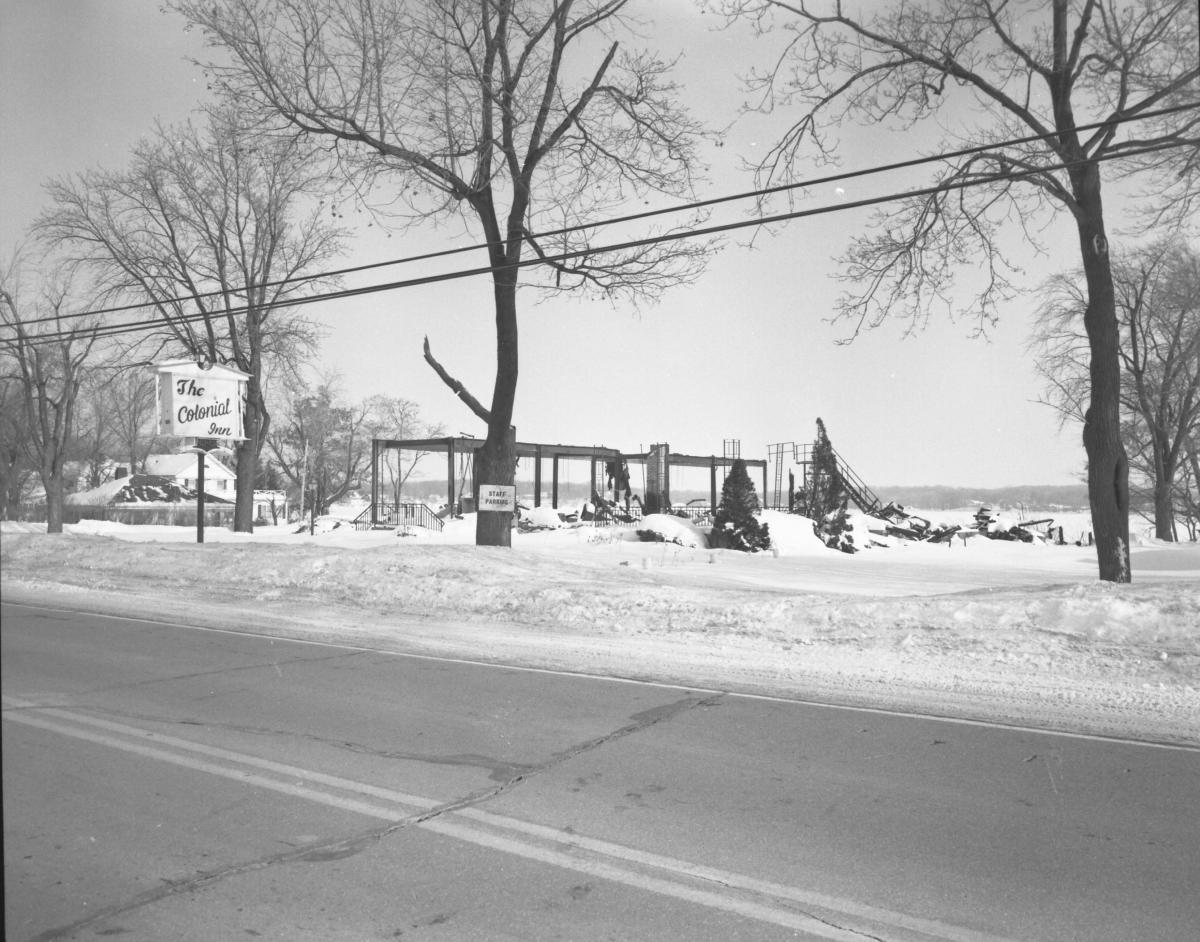
This Emmett Raettig photo shows that only the main beams and chimney of The Colonial Inn on the west shore of Brown’s Lake were left standing following an explosion and fire on January 2, 1979. Subzero temperatures proved a problem, freezing lines as water was pumped from the lake. The Inn had its beginnings as a resort hotel in 1892 when Patrick H. Cunningham moved his barns across the road and built a new 25-room summer hotel, called The Auditorium, on his lake property. In 1926, the hotel became the club house for the new Brown’s Lake golf course that had opened across the road. In 1939, the club house was sold to Ben Hoffman, who renamed it the Colonial Club. The restaurant business changed hands several times until G. Gardner Johnson bought it in 1973. Johnson changed the name to The Colonial Inn, and operated or leased out the business until the time of the fire. The property is now occupied by private residences.
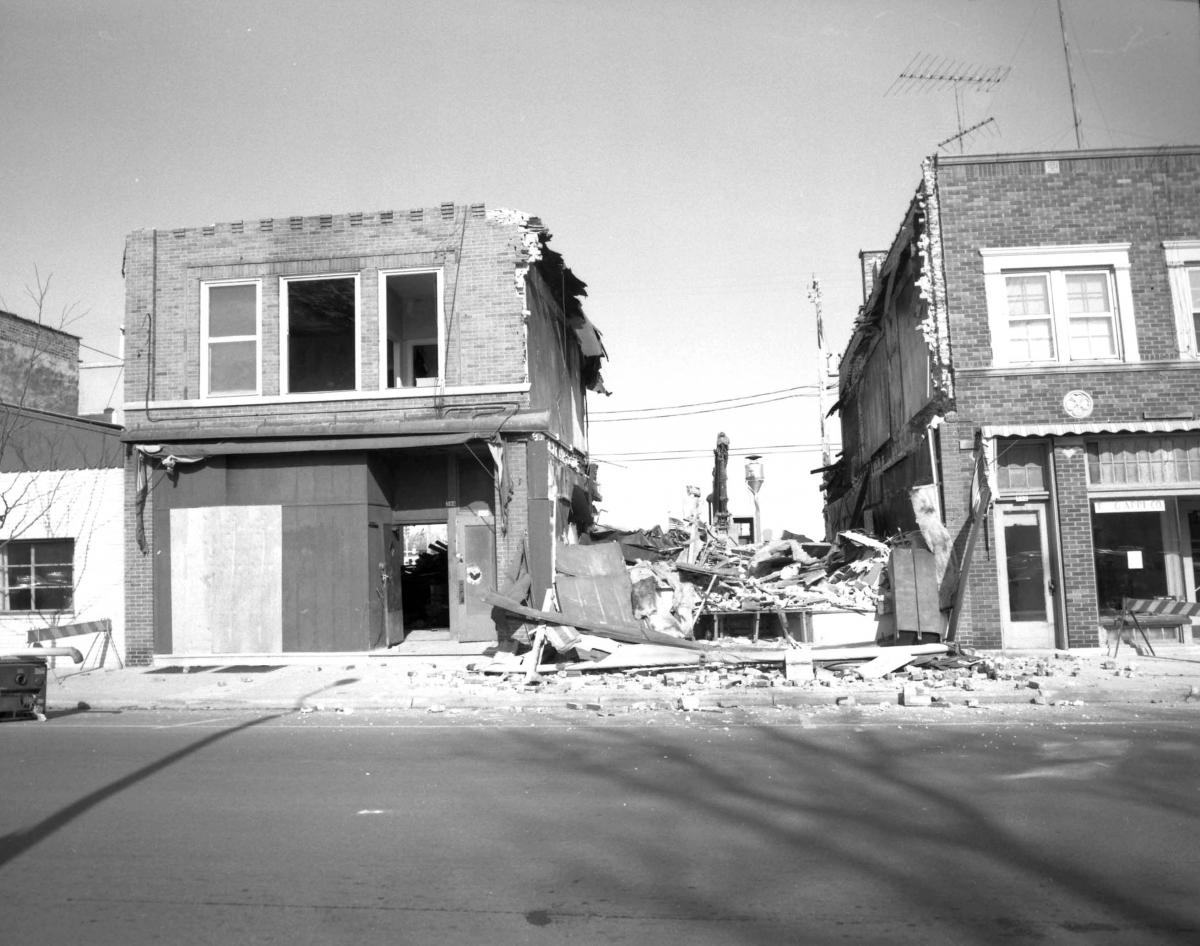
This March 1985 Emmett Raettig photo shows the wreckers at work taking down the former Palace Restaurant and Bowling Alley building on Pine Street after a damaging early morning fire in October 1984 had gutted the building. The fire, which began in a false ceiling over the bar room area, resulted in about a dozen firefighters being sent to Memorial Hospital for treatment for smoke inhalation, although only one required hospitalization. Three tenants of the two upstairs apartments got out of the building unhurt. Palace owners James Walsh and Robert Watson re-opened their restaurant in a new building on the site in August 1985. The current occupant, Gabby’s Palace, was opened by David and Sandy Corbett in 1992.
CIRCUS PARADE THROUGH DOWNTOWN BURLINGTON IN 1908
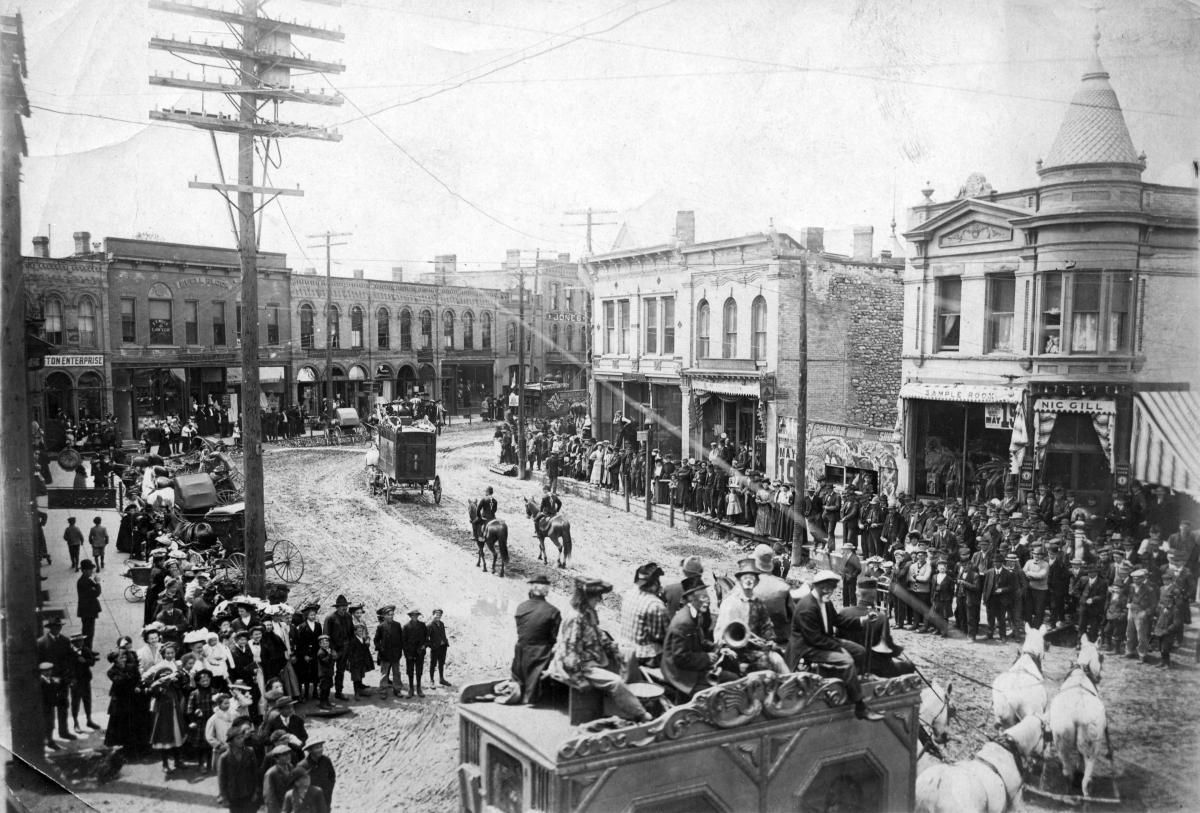 Spectators lined the streets as the Gollmar Brothers Circus paraded through downtown Burlington early in the afternoon on Tuesday, May 19, 1908. The photo, taken from the corner of Chestnut and Pine Streets by Burlington photographer Howard A. Wood, was among a collection of early Burlington views recently donated to the Burlington Historical Society by Judy Townsend and brought to the Museum by Leroy Stoehr.
Spectators lined the streets as the Gollmar Brothers Circus paraded through downtown Burlington early in the afternoon on Tuesday, May 19, 1908. The photo, taken from the corner of Chestnut and Pine Streets by Burlington photographer Howard A. Wood, was among a collection of early Burlington views recently donated to the Burlington Historical Society by Judy Townsend and brought to the Museum by Leroy Stoehr.
The Gollmar brothers, cousins to the more famous Ringling brothers, started their own circus in Baraboo in 1891 with a moderate-sized overland wagon circus. The business grew steadily until 1903 when the Gollmars switched to rail transportation. At its peak the show used as many as 22 rail cars and became a major circus in Wisconsin and other midwestern states. Between 1904 and 1925, the Gollmar Brothers Circus appeared in Burlington in seven different years. The Ringling Brothers Circus appeared in Burlington twice – in 1889 and 1891.
The 1908 circus train arrived in Burlington early Tuesday morning from Freeport, Illinois. According to one of the Burlington papers, “It was a sorry-looking outfit of canvas and wagons, mud being the predominating feature and everything looked as though it had been soaked for weeks, which in fact it had been. On account of the rain the parade (which had been scheduled for 10 a.m.) was not given till noon.”
The circus gave two performances. The afternoon performance, according to the Standard Democrat, was witnessed by a fair crowd, while the evening show had a big attendance. It said that the Gollmar Bros. had a good menagerie, with its herd of eleven elephants being the best ever seen in Burlington. It added that the acrobatic performances were all that could be wished, but the riding was not up to the usual standard. The other Burlington paper, the Free Press, said that one of the best things about the show was that it fulfilled its promise about being clean and respectable. The paper added that there were no grafters or gamblers observed.
- - - - -
The building on the right with the distinctive turret was occupied by Nic Gill’s saloon at the time of the photo. The building had been erected by William B. Finke (of the Finke-Uhen Brewery) in 1902, replacing an earlier wooden building. Occupants after Gill included a series of taverns (and soft drink parlors during Prohibition) until 1944, when Carl Rubach moved his men’s clothing store, called Carl’s Tog Shop, into the building. That was followed by Pieters Men’s Wear in 1954 and Burlington Savings and Loan in 1958.
After the Savings and Loan moved out in 1963, Charles and Florence Natale opened a pizza restaurant. Following a fire in 1978, the building’s turret and upper story were removed and the Natales re-opened the restaurant in a single-story building, operating it until 1987. The building has since housed other restaurants, including the current Zumpano’s.
The vacant lot to the left of the corner building was filled later in 1908, when Andrew Fenn put up a brick building. The first occupant of that building was the Crystal Theater, which was followed in 1911 by a ladies’ furnishings store called The Fashion Cloak and Suit Store. After that firm went out of business in 1913, William E. Flack and George Miller of Elkhorn opened a drug store in the building. Frank Tobin joined the firm as a druggist in 1914 and bought the store in 1915. Leonard Gums took possession in 1959 and, in 1963, formed a partnership with Art McCourt and Donald Schultz. After Tobin’s Drug Store moved out in 1966, the Natales expanded their restaurant into the building, which was also reduced to one story after the 1978 fire.
The building to the left of the vacant lot was occupied in 1908 by Simon M. Reinardy’s drug store. Later occupants of the building, which was erected in 1874, included Fred Oberg’s Palace of Sweets; ice cream and sweet shops operated by Clarence Partee, William Parkins, and Sam Jarvis; Floyd and Charles Dunham’s restaurant; William Pieh’s Sodabar restaurant; the Sport Mart; Pic Shoe Outlet; Off The Record; Absolu Salon; a consignment shop; a tattoo parlor; and a tobacco store. The building was vacant at the time of this writing.
The next building, with the rectangular upper windows, was built in 1889 by Joseph Hoch. At the time of the photo, the Burlington Post Office occupied the building. After the post office moved out later in 1908, the building was occupied by a series of drug stores operated by Thomas G. Buchan, Leslie Mealy and Charles Stupka, and Charles Jackson. After Jackson moved his drug store in 1952, Charles B. “Ceb” McCanna opened The Carousel, which featured a frozen dairy product called “Penguin.” Subsequent occupants included Miller’s Jewelers, Jane’s Country Mouse Antiques, Chocolate City Souvenirs, Handcrafted Gallery II, and others. The building was vacant at the time of this writing.
KORTH BUILDING
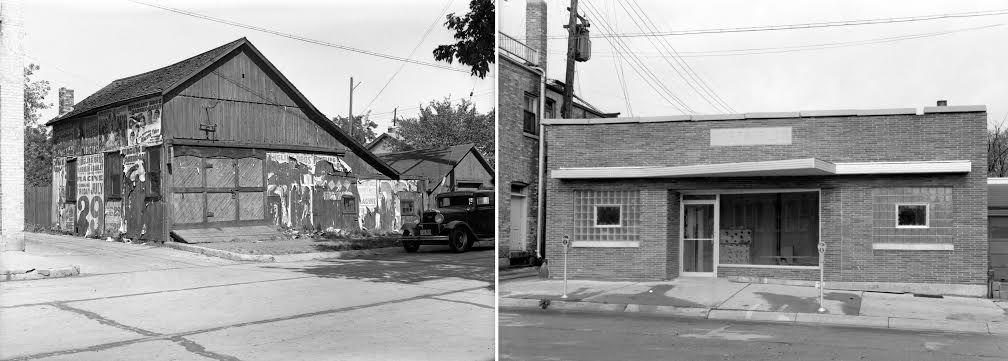 Two buildings that no longer exist, but which stood at different times on the east side of the alley on the north side of Washington Street, are shown above. The building at the left was known as the Beller barn. The building at the right, which replaced the Beller barn in 1939, was known as the Korth Building. Today, the property on which these buildings stood is part of the City's parking structure at the corner of Washington and Dodge streets.
Two buildings that no longer exist, but which stood at different times on the east side of the alley on the north side of Washington Street, are shown above. The building at the left was known as the Beller barn. The building at the right, which replaced the Beller barn in 1939, was known as the Korth Building. Today, the property on which these buildings stood is part of the City's parking structure at the corner of Washington and Dodge streets.
The photo of the Beller barn was taken in 1938 by the late Robert L. Wagner, a local banker with a lifelong interest in photography. The photo was in a group of Wagner's photos that were recently donated to the Historical Society by his daughter, Margie, and her husband, Mark Johnston.
Frank Beller, later to become Burlington's village marshal and the city's first police chief, bought the property, which was then an empty lot, in 1893. He put up the wooden building, which was first leased by Patrick H. Cunningham for use as a meat market. In 1911 Beller's son, Frank, Jr., a recently graduated veterinarian, remodeled the building for use as a veterinary office and animal hospital. He continued that business until moving to Montana in 1914.
As automobiles started becoming more and more popular, Patrick Cunningham's sons, Arthur J. and John, rented the building in 1914 to start their Buick agency. The Cunningham Bros. agency remained in the building until 1917, when it moved to the former Agner Garage building on the corner of Chestnut and Dodge streets (where Chocolate Expressions is now located).
In 1937 the Burlington Safety Commission recommended that the Beller property be turned into a parking lot. It proposed that the old sheds be razed and that the City rent the parking lot. While the Commission's parking lot recommendation was not implemented at that time, the Beller barn was razed in 1939 to make way for Elmer Korth, who leased the property from the Frank Beller estate, to erect a new one-story, 40 by 70 foot building. The building, of concrete construction and insulated throughout, was to house a grocery store of the "Piggly-Wiggly" type with the merchandise all being displayed on counters where customers could help themselves.
Elmer and his wife, Eva, had opened a Royal Blue grocery store in 1933 in the Weiler Building at what is now 420 N. Pine Street. When the building on Washington Street was completed in August 1939, the Korths moved the Royal Blue grocery business there. According to a Free Press article reporting on the grand opening, the store was a most modern and up-to-date grocery store. It was air conditioned and had rest rooms, a modern lunch counter, and parking space for customers in back of the store. It also had 24 feet of refrigerated counters and free delivery.
After the Korths retired for health reasons in 1944, their daughter, Billie, and her husband, Lester Fritz, operated the Royal Blue store for several years. In 1952, after the store had been discontinued, Francis Noble rented the building for use as a sport store but that plan was not completed. Mrs. Korth (her husband had died in 1946) then had a brick front installed on the building, which was rented by Elmer Ebert's Bulletin Publishing Co. The righthand photo, taken by Emmett Raettig in 1954, shows the building with its new front.
Ebert moved his firm into the Korth Building late in 1954. The firm remained in the building until 1985 when Ebert's successors, Lynn Koshak and Sue and Jack Stardy, moved the business to the Bankes Building at 516 N. Pine Street, currently the site of Burlington Flowers and Interiors. Subsequent businesses occupying the Korth Building included Kool Kats Speed and Custom, Inc., Spectrum Electronics, and Stained Glass Overlay.
The City bought the property in 2009 and razed the building as part of its downtown redevelopment plan involving a hotel, commercial buildings, and a parking structure. The hotel and parking structure opened early in 2011.
THREE BANKS
Remember When . . . Burlington had three banks, which were all in the downtown area, were all locally owned, and were all located within a block of one another.
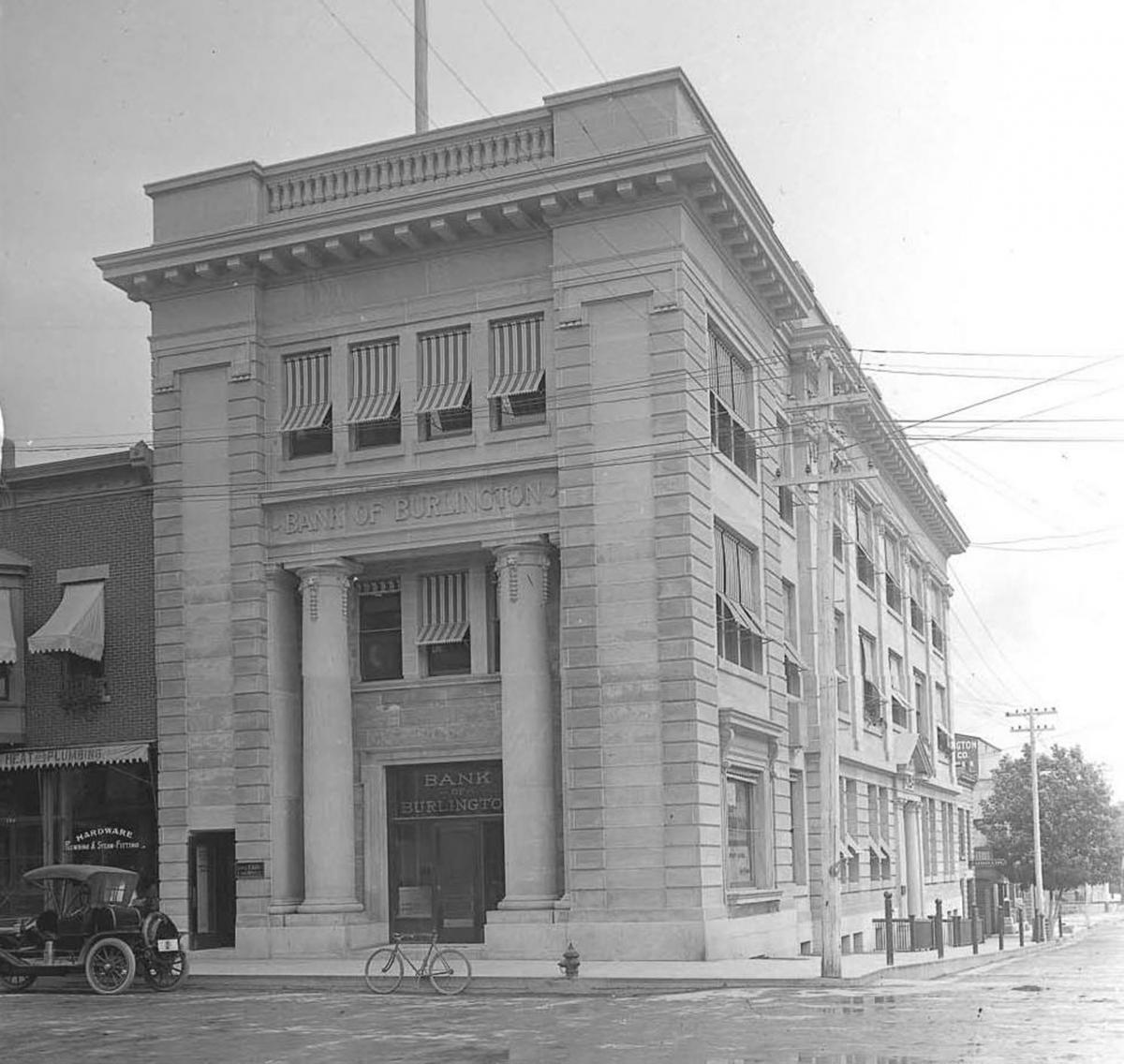 The Bank of Burlington was on the northeast corner of Chestnut and Pine Streets in the building that is occupied today by May’s Insurance Company. The building, which is shown in a Howard Wood photo taken about 1912, was erected in 1909 specifically for the Bank of Burlington, which had previously been located, since its founding in 1872, above the bend in Chestnut Street. The 1909 building was erected by the bank’s president, Charles B. McCanna, who also owned the Wisconsin Condensed Milk Company. At one time, heat for the bank was supplied by an underground pipe from the milk factory, which stood east of the railroad tracks on “lower” Chestnut Street. The Bank of Burlington remained in the building until 1970, when it moved to a new building on S. Pine Street. The bank was bought in 1995 by the M & I Bank, which in turn was bought by the Bank of Montreal, now BMO-Harris Bank, in 2010.
The Bank of Burlington was on the northeast corner of Chestnut and Pine Streets in the building that is occupied today by May’s Insurance Company. The building, which is shown in a Howard Wood photo taken about 1912, was erected in 1909 specifically for the Bank of Burlington, which had previously been located, since its founding in 1872, above the bend in Chestnut Street. The 1909 building was erected by the bank’s president, Charles B. McCanna, who also owned the Wisconsin Condensed Milk Company. At one time, heat for the bank was supplied by an underground pipe from the milk factory, which stood east of the railroad tracks on “lower” Chestnut Street. The Bank of Burlington remained in the building until 1970, when it moved to a new building on S. Pine Street. The bank was bought in 1995 by the M & I Bank, which in turn was bought by the Bank of Montreal, now BMO-Harris Bank, in 2010.
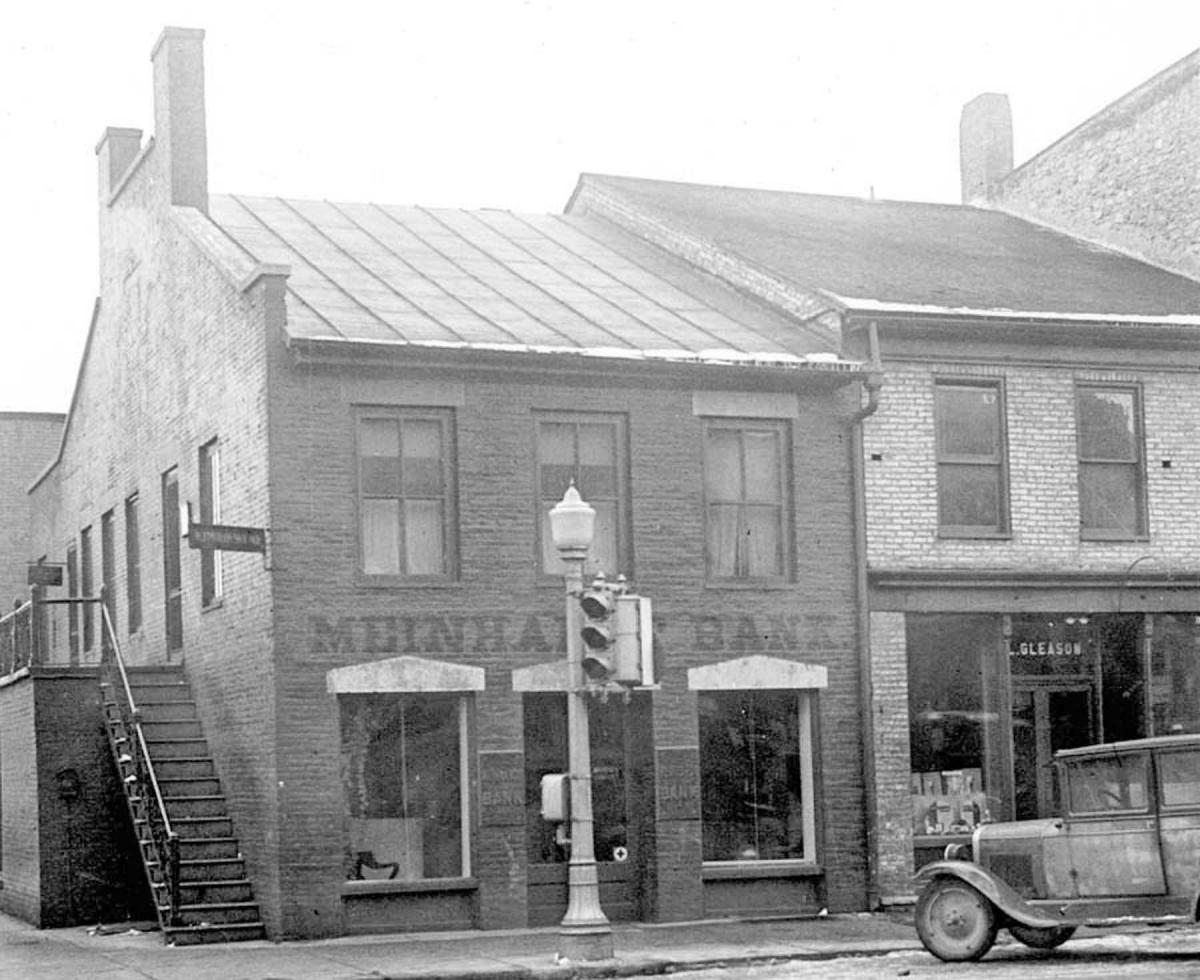 The Meinhardt Bank was on the southwest corner of Chestnut and Pine Streets, “kitty-corner” from the Bank of Burlington. Anthony Meinhardt had established the bank as a private bank in 1891 and located it in the building shown in the 1935 Wisconsin Historical Society photo by Anthony Wuchterl. The building had been erected in 1847 by Caleb Barns, who had both a law office and a banking business on the second floor. Successor bankers – including Sharp & Crane, Houghton & Flack, and Houghton & Berger – remained on the second floor while the first floor was leased to a series of grocery stores and other businesses. In 1890, Anthony Meinhardt, who then owned the building, fitted up the first floor as a bank to be run by him and his daughter, Eda. After Anthony’s death in 1891, his widow, Eliza Riel Meinhardt, became bank president with son Albert as vice president and Eda as chief cashier. The bank was incorporated as a state bank in 1897 and operated as a closely held family corporation for most of its history. In 1969 the bank was acquired by the Marine Corporation, which in turn was acquired by Bank One in 1988. Bank One merged with J. P. Morgan Chase & Co. in 2004. Today, the bank, which expanded into the adjacent buildings in the 1950s and 1960s, is known as Chase Bank.
The Meinhardt Bank was on the southwest corner of Chestnut and Pine Streets, “kitty-corner” from the Bank of Burlington. Anthony Meinhardt had established the bank as a private bank in 1891 and located it in the building shown in the 1935 Wisconsin Historical Society photo by Anthony Wuchterl. The building had been erected in 1847 by Caleb Barns, who had both a law office and a banking business on the second floor. Successor bankers – including Sharp & Crane, Houghton & Flack, and Houghton & Berger – remained on the second floor while the first floor was leased to a series of grocery stores and other businesses. In 1890, Anthony Meinhardt, who then owned the building, fitted up the first floor as a bank to be run by him and his daughter, Eda. After Anthony’s death in 1891, his widow, Eliza Riel Meinhardt, became bank president with son Albert as vice president and Eda as chief cashier. The bank was incorporated as a state bank in 1897 and operated as a closely held family corporation for most of its history. In 1969 the bank was acquired by the Marine Corporation, which in turn was acquired by Bank One in 1988. Bank One merged with J. P. Morgan Chase & Co. in 2004. Today, the bank, which expanded into the adjacent buildings in the 1950s and 1960s, is known as Chase Bank.
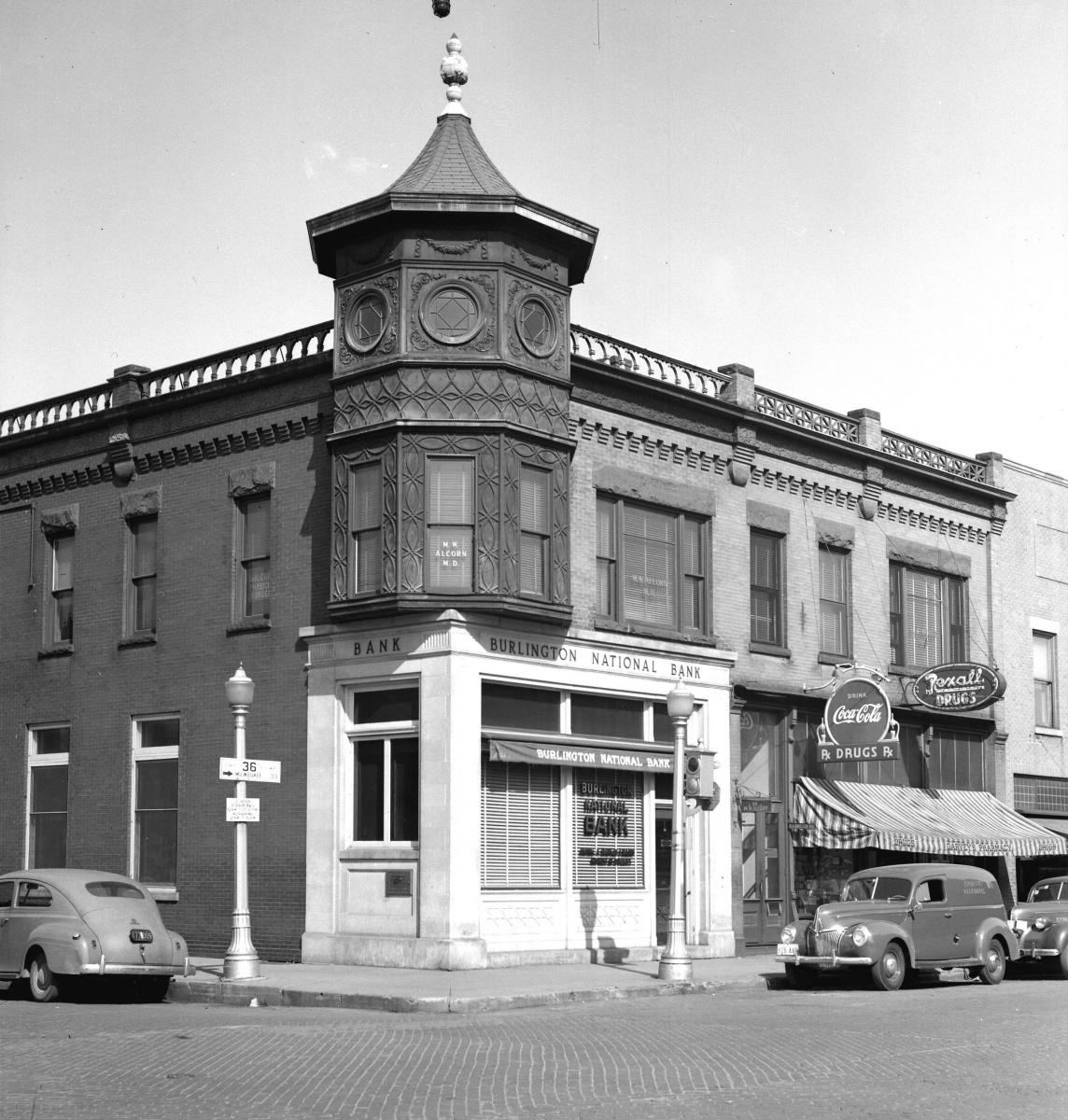 The Burlington National Bank, which was on the northeast corner of Chestnut Street and what is now Milwaukee Avenue, was established in 1920 by a group of Burlington area residents, including Harold A. Runkel, William and Albert Bushman, William S. Wilson, William G. and Gustave C. Rasch, George Waller, and William Rosenberg. They entered into a lease with the Bushmans for the building, shown in a circa 1950 photo by Burlington photographer John Zwiebel. The building, which had previously served as the Bushmans’ tavern, is occupied today by Oldenburg Insurance. The bank remained in the building until 1960, when it moved to a new building on the corner of what is now Milwaukee Avenue and N. Kane Street. In 1976, the bank was changed from a national chartered bank to a state chartered bank and the name changed to First Bank and Trust Company. After the company acquired a bank in Albany, Wisconsin, in 1984, the name was again changed, this time to First Banking Center. Today, the bank is owned by the Talmer Bank and Trust Company, formerly First Michigan Bank, which acquired it in 2010.
The Burlington National Bank, which was on the northeast corner of Chestnut Street and what is now Milwaukee Avenue, was established in 1920 by a group of Burlington area residents, including Harold A. Runkel, William and Albert Bushman, William S. Wilson, William G. and Gustave C. Rasch, George Waller, and William Rosenberg. They entered into a lease with the Bushmans for the building, shown in a circa 1950 photo by Burlington photographer John Zwiebel. The building, which had previously served as the Bushmans’ tavern, is occupied today by Oldenburg Insurance. The bank remained in the building until 1960, when it moved to a new building on the corner of what is now Milwaukee Avenue and N. Kane Street. In 1976, the bank was changed from a national chartered bank to a state chartered bank and the name changed to First Bank and Trust Company. After the company acquired a bank in Albany, Wisconsin, in 1984, the name was again changed, this time to First Banking Center. Today, the bank is owned by the Talmer Bank and Trust Company, formerly First Michigan Bank, which acquired it in 2010.
WISCONSIN CONDENSED MILK CO. - 1903
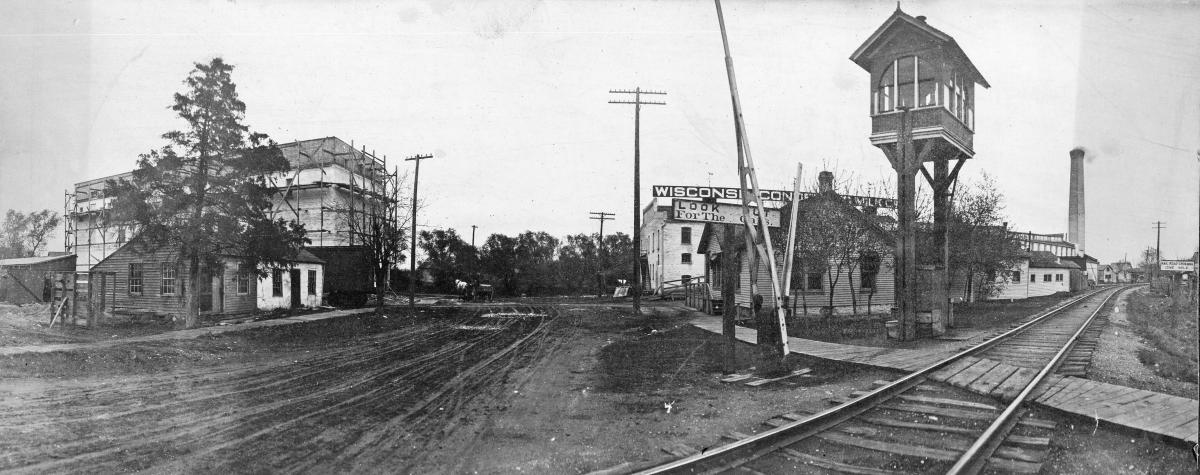
About the only things in this 1903 photo that someone looking east on Chestnut Street toward the White River would recognize today are the railroad tracks and the trees in the distance. All the buildings, the utility poles, and the other structures are just memories. Even the dirt road and wooden sidewalks have been replaced by ones made of concrete, and the railroad gate is now an automated barrier with blinking warning lights on the west side of the tracks.
The photo, which was taken with an Al-Vista panoramic camera manufactured in Burlington, was recently donated to the Historical Society by Patrick and Georgia McCanna.
At the time of the photo, the Wisconsin Condensed Milk Co., owned by Patrick’s great grandfather, Charles B. McCanna, was putting up a cold storage warehouse across Chestnut Street from the company’s main plant. The scaffolding used in installing the nearly 80,000 bricks that enclosed the warehouse can be seen along the building’s walls. The house on the left nearer the camera was known as the Davis house. That property, purchased by the Condensed Milk Co. in 1899, became the site of the company’s tin can manufacturing plant.
The site was subsequently occupied by Hi-Liter Graphics, before being cleared in 2001 as part of Burlington’s Riverfront Development Project. The Charcoal Grill restaurant now occupies the property.
The railroad signal tower was one of two in the central part of Burlington at the time of the photo. The other was at Jefferson Street. The towers were manned from 6 in the morning until midnight, with the watchmen working 9 hour shifts. The watchmen would descend from the towers to operate the railroad gates and warn horse-drawn and, later, motorized vehicles, pedestrians, and riders of the approaching trains. The Chestnut Street tower was removed in 1930 when the Soo Line installed automatic crossing signals at Chestnut, Jefferson, and Washington streets. The Jefferson Street tower was moved at that time to Washington Street, with one watchman on duty during the day to regulate the signal lights during switching operations. The Washington Street tower was taken down in 1964.
The small building just east of the signal tower served as the Wisconsin Condensed Milk Co.’s office at the time of the photo. Some of that building’s occupants in later years included Mary Amoreaux’s A.A.A. Advertising Agency, Darlene Ceramics, Lennie Marx’s Apostolic church, and Kris Thole’s Peddler’s Daughter. The frame buildings to the south of the office building housed various operations of the Condensed Milk Co.
The large white brick building seen extending from Chestnut Street to the tall smokestack on Washington Street was the main plant of the Wisconsin Condensed Milk Co. The company, incorporated by Charles B. McCanna, Robert G. Fraser, and Louis Rohr in 1898, grew out of a cheese and butter business that McCanna had started in Burlington with a cheese factory in 1882.
The condensed milk company, the first and largest such firm in Wisconsin, was a valuable industry for area dairy farmers and helped earn Wisconsin the designation as “America’s Dairyland.” A 1903 report said that more milk was delivered in Burlington every morning than in any other Wisconsin city or village.
The Nestlé Food Co. bought the Wisconsin Condensed Milk Co. in 1919, took possession in 1920, and renamed it Nestle's Milk Products, Inc. Burlington became Nestle's midwest division headquarters, and in 1922, the plant added powdered milk to its line. During World War II, the plant supplied the armed forces with canned and powdered milk. After the war and as the southern states developed a dairying industry, demand dropped. Nestlé closed the milk plant in 1950 and sold the can shop in 1959.
In 1964, Nestlé returned to Burlington, breaking ground for its chocolate plant on South Pine Street. That plant, which opened in 1966, has become one of Burlington's largest
SOME "ORPHAN TRAIN" TRAVELERS FOUND HOMES HERE
Dressed in their Sunday best, numerous children from eastern cities boarded trains and headed west. They were full of anticipation, but also fear of the unknown. They were going to a land of strangers.
The children included orphans, half-orphans, foundlings, runaways, and abandoned or neglected waifs living in poverty and hopelessness. Some had migrated from other countries before disease, despair, and death separated them from their families. They had no one to turn to and nowhere to go.
Charles L. Brace, a New York City pastor, was disturbed by the street children's plight and thought what they needed were loving, Christian homes. He believed they would flourish if taken out of their appalling surroundings. He began a program in the mid-1850s modeled after one begun in Boston several years earlier.
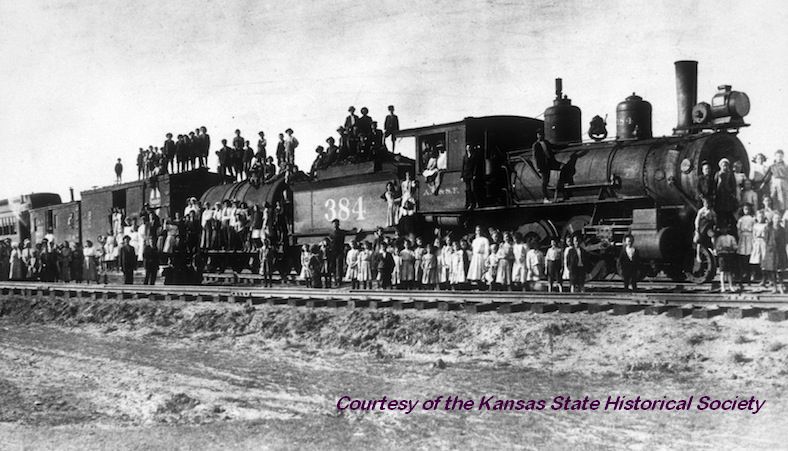 To give the children a fresh start, they were placed on trains, usually under the care of one or more "placing agents," and sent to rural America.
To give the children a fresh start, they were placed on trains, usually under the care of one or more "placing agents," and sent to rural America.
The children traveled to places planned in advance where they were expected. Once there, the children who had been "requested" were united with the requesting families. The remaining children were taken from the train to be "displayed" at a central place, such as a town hall. Local families were urged to take the children into their homes and treat them as their own and the children were expected to work and contribute as family members. While some older children were taken mainly to serve as domestics or farm hands, or to work at other jobs, follow‑up visits by charity aid workers found most of the children were living satisfactory lives.
Several other aid societies embraced the program. Between 1853 and 1929, an estimated 150,000 to 200,000 children were taken west on the "Orphan Trains." The relocation program ended with the advent of organized foster care closer to the children's homes. In 1996 it was estimated that about 2 million Americans were descendants of Orphan Train riders.
Orphan Trains Visited This Area — The Orphan Trains brought a number of children to Burlington and nearby places. The arrival of one group in December 1869 was reported in the Burlington Standard. It said that R. B. Graham, general agent of the Baldwin Place Home for Little Wanderers in Boston, and 26 children had visited the area the previous week. At Kenosha, homes were found for 6 children; at Racine, 8; and at Union Grove, 1. On reaching Burlington, 11 remained – 5 girls and 6 boys.
As a class, the paper said, the children were bright, good looking, and well behaved. The reporter said it was sad to see such children in want from lack of friends to give them food, clothing, and shelter. "Beyond this," he added, "how do they need care, and culture, and Christian training, and, what are more, the affection and endearments of a Christian home."
In Burlington, the children were made welcome and on Friday evening they were present at the Christian Conference at Plymouth Church where Mr. Graham made a "forcible" address. On Saturday at the hotel, a considerable number of families indicated interest, whether from duty or expediency, in "taking" or "adopting" the children. Right glad are we, the paper said, that 8 of the 11 children found homes among us – a girl each with Joseph and Mary Wackerman and with William and Mary Jackson of Burlington, a girl with J. L. Taylor of Lyons, a brother and sister with John McDonald of Brighton, and a boy each with Elliott C. Benson and George W. Bushnell of Burlington and Huron J. Hawks of Lyons.
At Elkhorn, Jeremiah Russell took a boy and George Cameron of Lafayette took the remaining boy. Thus, all were located except for a young lady whom Mr. Graham took to Racine where he expected to find a home for her.
About 6 months later, the Standard reported that another company of 40 homeless children were brought to this area in June 1870. Of the 40, eight were located in this vicinity – a boy and a girl with Ephraim and Gustavia Sawyer of Burlington, a girl each with George W. Bushnell and William Rooker of Burlington, a boy with Louis and Ann Codman of Rochester, a boy with Mr. Carpenter of Honey Creek, and a boy with Huron Hawks and a girl with Mr. F. Taylor of Lyons.
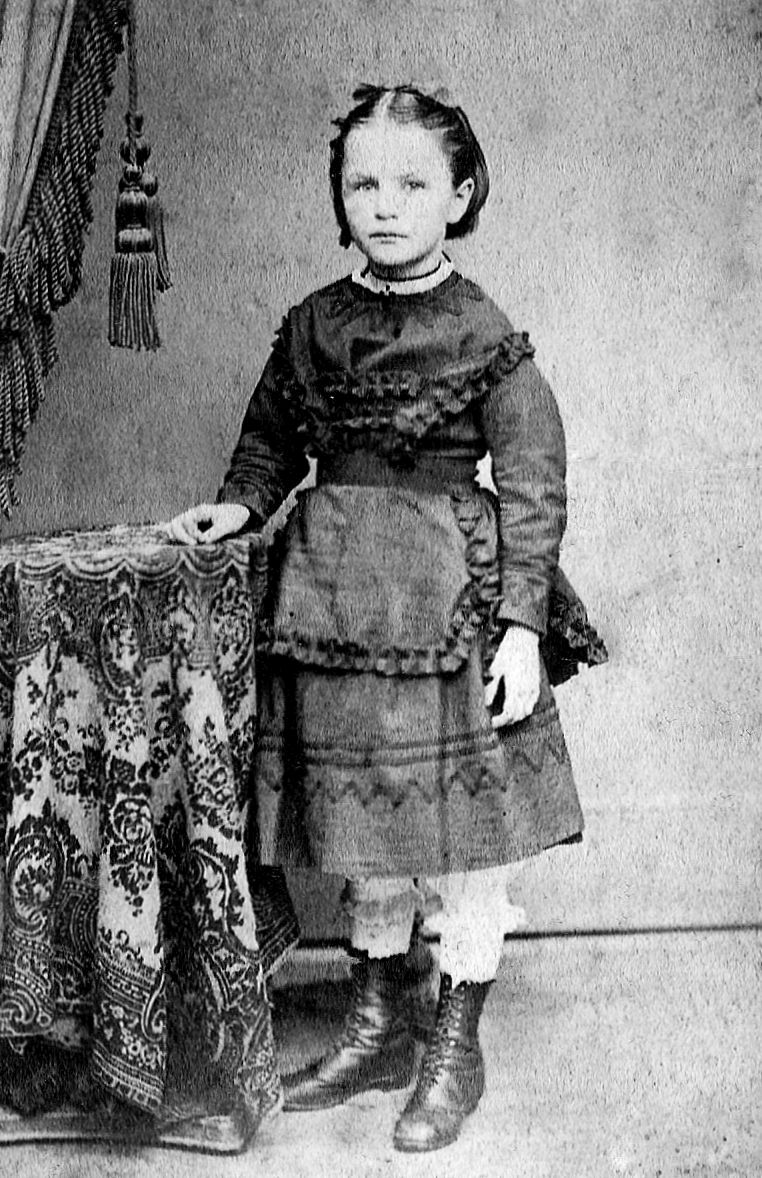 One Orphan's Story — Born in Athol, Massachusetts, in April 1863 and orphaned in early childhood, Alice Wright, shown in the accompanying photo, came west on the December 1869 "Orphan Train" referred to above. After finding a home with Joseph and Mary Wackerman of Burlington, she was adopted by them and received her education at Burlington's Union School. The school, across Dyer (now N. Kane) Street from the Wackerman home, was later named Lincoln School and now houses the Burlington Area School District offices.
One Orphan's Story — Born in Athol, Massachusetts, in April 1863 and orphaned in early childhood, Alice Wright, shown in the accompanying photo, came west on the December 1869 "Orphan Train" referred to above. After finding a home with Joseph and Mary Wackerman of Burlington, she was adopted by them and received her education at Burlington's Union School. The school, across Dyer (now N. Kane) Street from the Wackerman home, was later named Lincoln School and now houses the Burlington Area School District offices.